21. THE EARLY 1960s

KENNEDY AND THE COLD WAR
CONTENTS
 The young, energetic, handsome The young, energetic, handsome
Kennedy becomes President
 The Kennedy White House as "Camelot" The Kennedy White House as "Camelot"
 Kennedy and the "New Frontier" Kennedy and the "New Frontier"
 The disastrous Bay of Pigs invasion in The disastrous Bay of Pigs invasion in
Cuba – April 1961
 The ongoing Congo Crisis The ongoing Congo Crisis
 South Africa's ethnic disputes South Africa's ethnic disputes
 The Soviets launch the first man into The Soviets launch the first man into
space – April 1961
 The failed East-West Summit – June The failed East-West Summit – June
1961
 The Berlin wall goes up – August 1961 The Berlin wall goes up – August 1961
 The Cuban Missile Crisis – October 1962 The Cuban Missile Crisis – October 1962
 Kennedy again attempts a soft approach Kennedy again attempts a soft approach
to the Cold War – summer (1963)
 Nasser – and growing tensions in the Nasser – and growing tensions in the
Middle East
 The mounting crisis in Vietnam The mounting crisis in Vietnam
The textual material on this webpage is drawn directly from my work
America – The Covenant Nation © 2021, Volume Two, pages 142-161.
THE
YOUNG, ENERGETIC, HANDSOME KENNEDY BECOMES
PRESIDENT |
|
America knew that it was not a perfect country,
but certainly understood what perfection should look and feel like, and
indeed sought growth toward that ideal. The Cold War raging in the
1950s and early 1960s made this imperative. To win the hearts of an
emerging Third World, to keep the Third World nations of Asia, Africa
and Latin America from falling under the Communist program emanating
from the Russian Kremlin, America needed to present to the world as
positive a face as possible in order to win these newly emerging
nations over to the "Free World" community of nations led by America.
The 1960 Democratic Party presidential nomination
Coming into the 1960 presidential
election, it looked fairly clear that Vice President Richard Nixon
would receive the Republican nomination. Only New York Governor Nelson
Rockefeller seemed to be a possible challenger, except that he let it
be known early on that he had no intentions of running for the
position. Thus Nixon was easily nominated as the Republican candidate
at the Chicago Convention. America’s U.N. Ambassador Henry Cabot Lodge,
Jr., was selected to be Nixon’s vice-presidential running mate.
On the Democratic Party side, the
situation was much more fluid. Adlai Stevenson tried again for the
nomination, but could not get much traction on this third attempt.
Texas Senator Lyndon Johnson, the powerful Senate majority leader,
sought the nomination, and brought solid-South or "Dixiecrat" support
with him to the Los Angeles Convention. But the front runner virtually
from the start was the charismatic John F. Kennedy, Massachusetts
senator and leading member of the rich and ambitious Kennedy clan, run
by John’s father, Joseph Kennedy, Roosevelt’s one-time American
ambassador to Great Britain (appointed by Roosevelt to get him out of
the country and out of Roosevelt’s way!). Helping advance John’s
political career was his brother, Robert, who had been serving as legal
counsel to a number of congressional committees, but who had also
served as John’s campaign manager as far back as John’s initial run for
the U.S. Senate in 1952. The brothers were close, and would remain
close.
As it turned out, Johnson was unable to
get any significant amount of support outside of the South, and Kennedy
went on to gain the Democratic Party nomination. But Kennedy then asked
Johnson to be his running mate – and Johnson accepted. Kennedy needed
the Southern vote to edge out Nixon, who had strong support across much
of the rest of the country, except among a number of old guard urban
bosses and state governors, who lined themselves and their political
organizations behind Kennedy.
John Fitzgerald Kennedy was second of
nine children born to the very prosperous and politically active
Irish-Catholic family of the Kennedys of Boston. John’s grandfather on
his mother’s side, "Honey Fitz" Fitzgerald, was a Democratic
congressman and two-term mayor of Boston, and his grandfather on his
father’s side, Patrick Joseph (PJ), was a businessman active in
Massachusetts Democratic Party politics, a political opponent of John’s
other grandfather! John’s father, Joseph, continued the family’s
activity in Massachusetts Democratic Party politics, as well as make a
huge fortune in the 1920s in stock market and real estate investments
and in Hollywood movie production, surviving the stock market crash by
getting out of his investments ahead of time, and then in the 1930s,
with Prohibition ended, moving into the whiskey import business. Joseph
Kennedy was a major financial supporter of Franklin Roosevelt in his
march to the White House in 1932, and Roosevelt rewarded this support
in 1933 by appointing Joseph Kennedy as head of the new Security and
Exchange Commission (SEC), assigned the task of cleaning up illegal
stock market activity. Two years later, Joseph would change jobs,
heading up the Maritime Commission. And three years after that, he
would be appointed by Roosevelt as U.S. Ambassador to Great Britain.
Thus young John Kennedy would grow up in
a world of privilege and power. But he worked hard to meet the family’s
expectations of high performance in all walks of life. He was educated
at a number of Catholic private schools before entering the prestigious
but Protestant (largely Episcopalian) Choate boarding school for his
high-school education. Then like his father, John would attend and
graduate from Harvard (1936-1940). During this time, he traveled abroad
extensively (not merely West Europe but also the Middle East and Soviet
Russia) and developed a very strong interest in international affairs,
writing a Harvard senior thesis critical of English diplomacy in its
dealing with Hitler, which was published in 1940 as a best-seller, Why England Slept.
But, unknown to the public, John Kennedy
suffered from a wide variety of deeply serious health problems, the
most critical and lasting being constant back problems. This would keep
him from being accepted into the army’s Officer Candidate School in
1940. But after some considerable exercising (and some inside help from
his father) he was able to get into the U.S. Naval Reserve, soon an
ensign and a member of the Office of Naval Intelligence staff in D.C.,
just shortly before the Japanese bombing of Pearl Harbor in late 1941.
The next year he received extensive
torpedo-boat training, becoming at the end of the year a trainer
himself, before receiving in April (1943) the overseas assignment in
the Pacific Solomon Islands of commanding a number of PT boats in
active war service. In August of that year his PT boat was rammed and
sunk by a Japanese destroyer. But Kennedy and his surviving crew were
able to swim (three miles) to shore, Kennedy bravely towing a badly
wounded crew member – at the same time that his own back was badly
injured. He returned to service in September, and helped rescue a
number of marines stranded on a Japanese-controlled island. But in
November he was sent to the hospital to begin treatment for his back
injury.
This was a very tough time for Kennedy, his older brother Joseph, Jr.
being killed in Europe the following year, and he himself having to
spend much of the rest of the war hospitalized for back treatment. He
was finally discharged from the Navy Reserve as a naval lieutenant
(March 1945). But he was able to carry himself admirably with a
substantial number of military decorations.
Being a talented writer, he (with his
father’s help) gained a position with the Hearst papers as a special
correspondent, even getting to cover the famous Potsdam Conference in
the summer of 1945.
But with his older brother’s death,
Kennedy’s father had other plans for his second son, John. The Kennedy
family plans had originally been for Joe, Jr., to enter American
politics, and reach even as high as the U.S. presidency itself. Now the
family turned to John to take up that responsibility. John’s father was
ready to invest considerable sums of money in support of John’s entry
into national politics.
That opportunity came with the 1946
Congressional elections in which the incumbent Congressman stepped
aside to become Boston mayor, allowing John to run for, and ultimately
win (quite substantially), the election for the 11th Congressional
District of Massachusetts. Thus John Kennedy’s long march to the White
House got underway.
As a freshman Congressman, he was
appropriately supportive of the fellow Democrat U.S. President Truman,
taking a special interest in the growing Cold War.
But even well before the beginning of his
third term as Congressman, he began laying the groundwork for a
senatorial run in 1952. In this he would be seeking to upset the
incumbent "Boston Brahmin" (member of Boston’s long-standing ruling
class) Henry Cabot Lodge, Jr., whose political ancestry reached back
even before the beginning of the 20th century (Lodge’s grandfather of
the same name had become a U.S. senator back in 1893 and head of the
Senate in the early 1920s). Henry Cabot Lodge, Jr., had been a U.S.
senator since 1937. It would be a tough race.
But Kennedy worked hard, and actually
succeeded that November in defeating Lodge with a relatively high
majority of the votes (the extensive Roman Catholic population of
Massachusetts helping him considerably).
During his 1952 campaign, Kennedy met the
sophisticated Jacqueline Bouvier, like himself a skilled journalist,
and very good-looking in a Hollywood sort of way. She also was
well-traveled abroad – as well as quite fluent in French (considered at
the time to mark someone as a true aristocrat) and sophisticated in
more a French than Middle-American manner. They dated, and following
his successful run for the U.S. Senate he proposed marriage. She
however did not give him an answer for some time – until she returned
from her coverage of the coronation of the very young British Queen
Elizabeth (June 1953). They would be married that September at Saint
Mary’s Church in Newport, Rhode Island, with Roman Catholic Cardinal
Cushing presiding. It was a major story, appearing on the society pages
of America’s newspapers.
Unfortunately, tragedy that seemed to
accompany Kennedy success hit the young family hard, Kennedy being
forced to undergo (and nearly dying from) spinal surgery in late 1954,
and Jacqueline suffering a miscarriage (1955) and a stillbirth (1956)
before she was finally able to give birth to a healthy daughter,
Caroline, in 1957.
Nonetheless, Kennedy was a rising star.
And at the Democratic National Convention of 1956, after delivering an
excellent nominating speech for presidential nominee Adlai Stevenson,
he came in second in the vote for Stevenson’s vice-presidential running
mate. Even at that, Kennedy now had national political recognition,
helping advance his career considerably.
This helped him gain a very easy
re-election in 1958 to a second term as Senator. At this point he began
to lay out a strategy for a run for the U.S. Presidency in 1960.
He was able to win some key Democratic
Party primaries going into the national convention. But it was still a
time in which party bosses controlled most of the votes at the
convention and Senator Lyndon Johnson was a well-known
behind-the-scenes operator. Going into the convention Kennedy had the
largest number of first-round votes, but knew that if he did not get
the nomination on that first round, Johnson would probably be able to
swing the convention his way after that. But as it turned out, Kennedy
was able to gain the majority he needed to receive the party’s
presidential nomination on that first ballot. Then, to the surprise of
many (and the irritation of his brother Bobby, John's campaign
manager), Kennedy asked Johnson to become his running mate. It would be
a very close race against Republican Vice President Nixon and Kennedy
would need the swing vote of the South where Johnson was from, and
where Johnson commanded a lot of support.
The presidential campaign that year would
be the first time that presidential debates would be presented via
television, and it would work greatly to Kennedy’s benefit. During the
all-important first debate (of four), Nixon did not present himself
visually in the cool format that Kennedy was able to project, and such
imagery would become increasingly important in the way Americans would
henceforth evaluate candidates.1
The debate turned on Nixon’s citing his own eight years of executive
experience as Vice President, plus the promise to continue down the
same prosperous path that the country had experienced during the
Eisenhower years. Kennedy countered by pointing out that America had
been allowed to fall behind the Soviet Russians in the vital technology
race, and by promising that as President he would push hard to get
America back into the lead in the space race.
As he campaigned, having his attractive
wife Jacqueline often at his side during the campaign merely added all
the more to the sense of sophistication that accompanied the Kennedy
presence.
His Catholicism was of some concern to
largely Protestant America. But he was quick to point out that he was
not campaigning on behalf of the Church, and that his Catholicism had
not been an issue to anyone back when he served his country in the
South Pacific! Actually, Kennedy’s religious loyalties remained largely
unknown to Americans (even while president). He was indeed a loyal
member of the Irish-Catholic world, although this seemed to be more a
matter of social identity than any particular personal theological
conviction. He followed fairly closely the ritual requirements of the
Catholic Church (principally, regular in his attendance at mass) but
not so much its moral disciplines. Also unknown to Americans at the
time, and even long after, Kennedy was a compulsive womanizer with an
insatiable appetite for mistresses, usually of the higher reaches of
society, including Hollywood (even the famous Marilyn Monroe).
Kennedy would bring God into his public
pronouncements in a way Americans at the time expected their presidents
to do so. But where he actually stood personally with God was not
really known to anyone other than Kennedy himself. His close
associates, including for instance his personal advisor Ted Sorenson,
remained unaware of Kennedy’s exact position on such matters as heaven
and hell and life after death. Certainly Kennedy lived a life of
prayer, personal pain as well as political pain being a big part of his
life. But that seemed to have no impact on his extensive womanizing
(which at the time was considered by the Washington press and
Congressional membership to be nobody’s business other than the
president himself).
Kennedy was thus a very private Catholic.
And Americans truly had no cause to believe that he would, as a good
Catholic, bring America under Rome’s papal authority. Anyway, with the
grand religious council held in Rome known as Vatican II (1962-1965),
the political requirements of "good Catholics" to come under Rome’s
political jurisdiction was put aside in support of a wider acceptance
of the legitimate place of other members of the Christian world
(meaning, among other things, that non-Catholics were no longer
destined at death to go to hell!).
In any case, the November (1960) presidential vote was close2
– very close indeed, with Kennedy gaining 49.7 percent of the vote and
Nixon 49.5 percent. The crucial electoral college majority, however,
would register as a bigger difference, with Kennedy’s 303 votes to
Nixon’s 219. Kennedy was thus elected as the country’s thirty-fifth
president.
1Just
prior to that first broadcast, Nixon had rushed in from a campaign
meeting and had not put on makeup (Kennedy had) needed to keep him from
looking washed out under the glaring T.V. lights. Nixon would not
repeat that mistake. But first impressions really stayed with people
who thought Nixon looked uncertain and even anemic. Radio listeners
however thought Nixon had sounded the more solid of the two debaters –
although at this point the TV audience (some 70 million Americans)
vastly outnumbered the radio audience.
2There
were serious questions about how Mayor Daily brought in the Illinois
vote for Kennedy. But Illinois going to Nixon instead of Kennedy would
not have changed the ultimate outcome.
The Nixon-Kennedy Presidential
Debates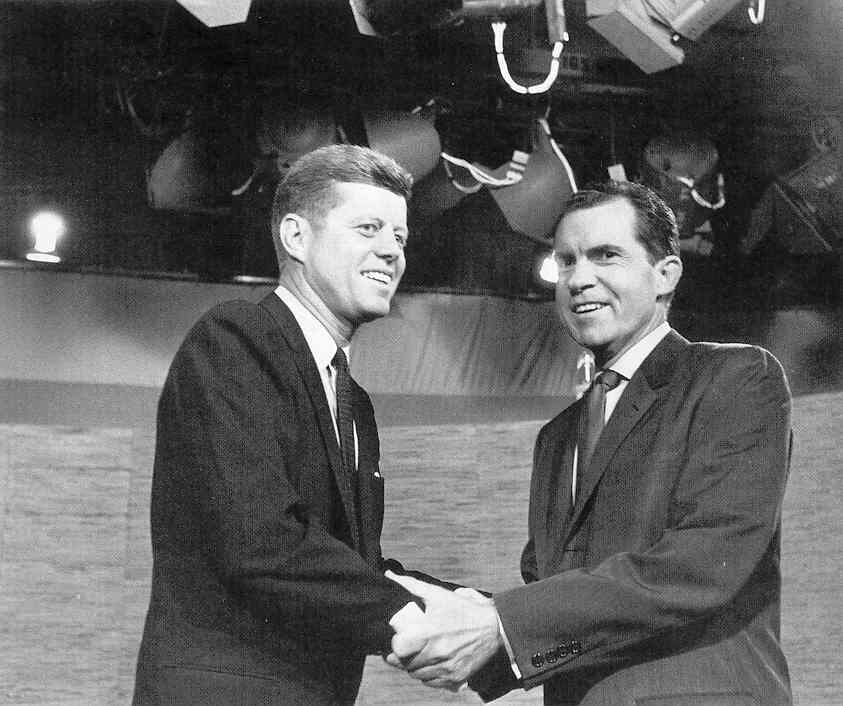
John Kennedy and Richard
Nixon before they begin the TV-radio debate series – 1960
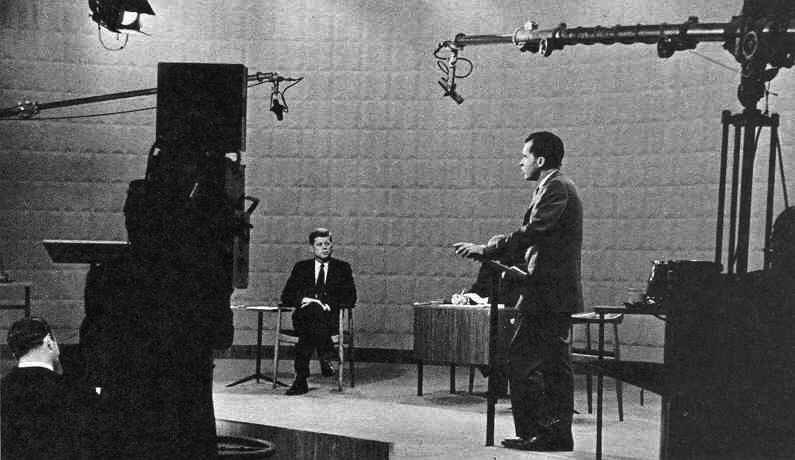 Nixon debating Kennedy -
1960
Nixon debating Kennedy -
1960
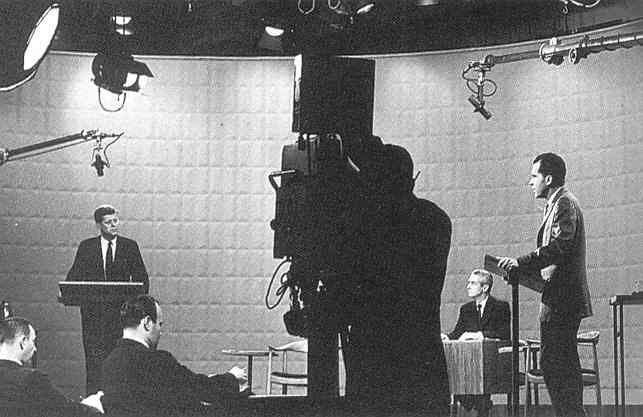 The Kennedy – Nixon Debates
- 1960
The Kennedy – Nixon Debates
- 1960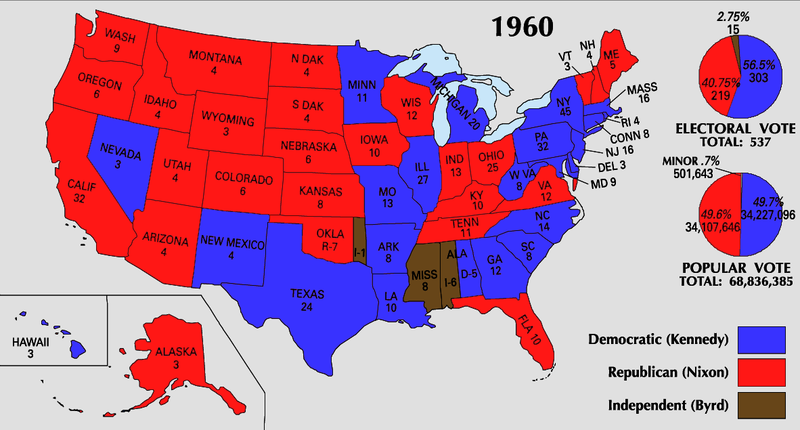
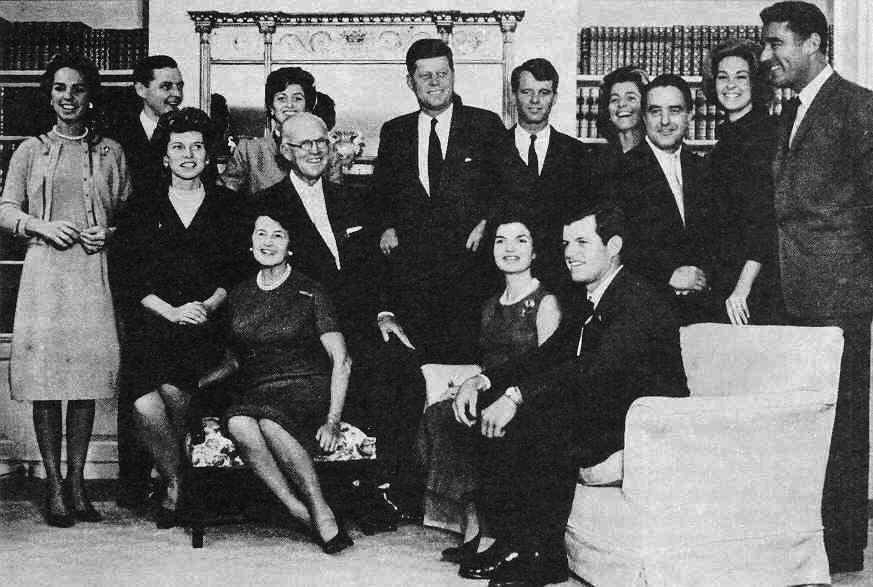
Some of the Kennedy Clan
- just after JFK's election to President – November 1960. (Seated from left: JFK's parents,
Mrs. (Rose) and Mr. Joseph Kennedy; his wife Jacqueline; his brother Edward; standing from left: Mrs. Robert
(Ethel) Kennedy; brother-in-law
Stephen Smith; Mrs. Smith; JFK; Robert
Kennedy; sister Mrs. Peter Lawford;brother-in-law
R. Sargent Shriver; Mrs. Edward (Joan) Kennedy; brother-in-law Peter Lawford
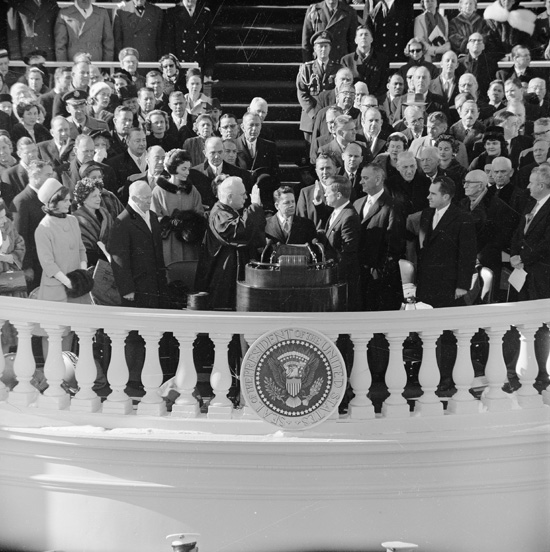 Inauguration of John Fitzgerald
Kennedy, January 20, 1961
Inauguration of John Fitzgerald
Kennedy, January 20, 1961
National Archives
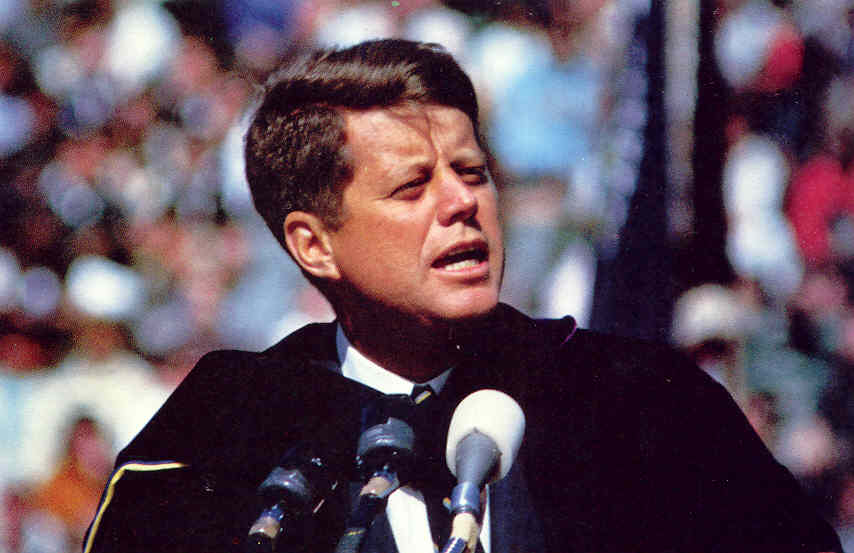 John F. Kennedy (1917-1963)
at the podium
John F. Kennedy (1917-1963)
at the podium
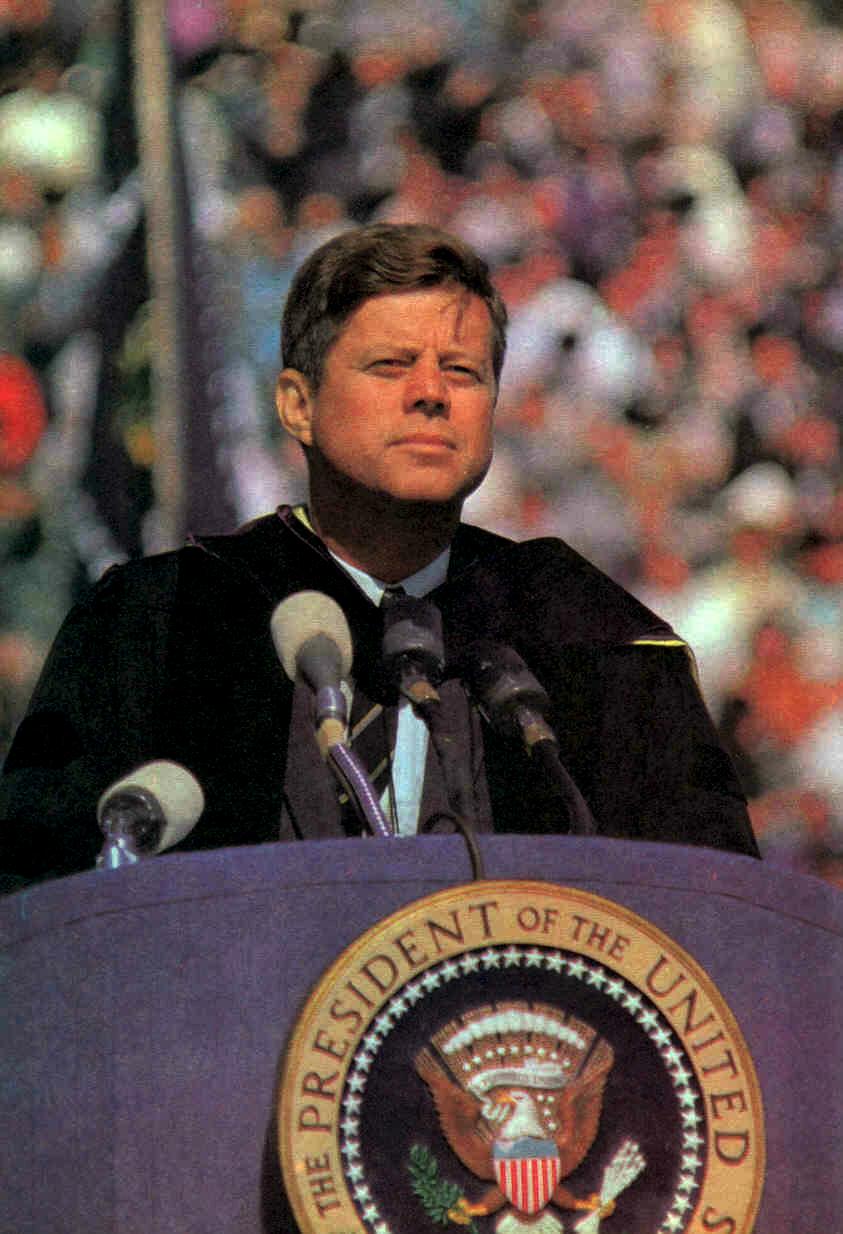
President John F. Kennedy
- 1961
THE KENNEDY WHITE HOUSE AS A VERY GLAMOROUS "CAMELOT" |
The term "Camelot" is often
used to describe the sheer elegance of the Kennedy White House
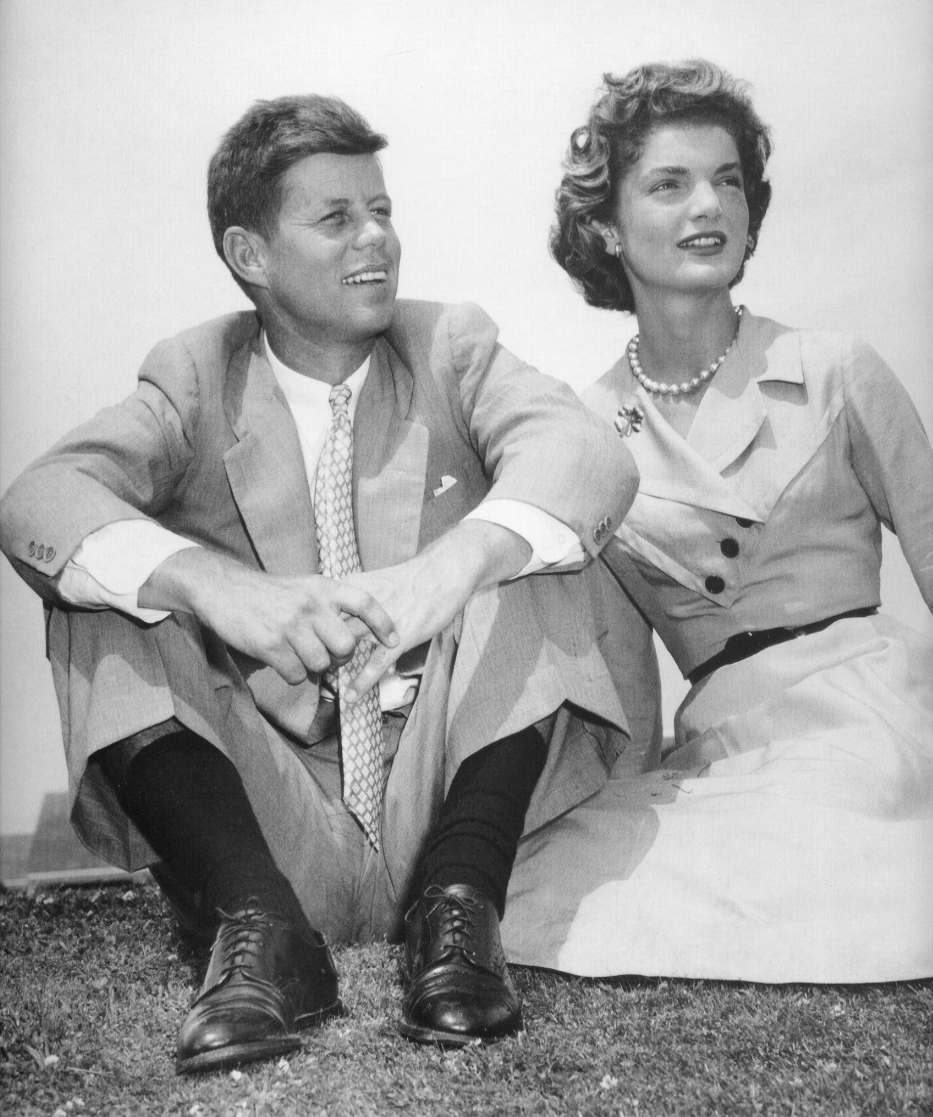
John F. Kennedy and Jacqueline
Bouvier just prior to their wedding in 1953
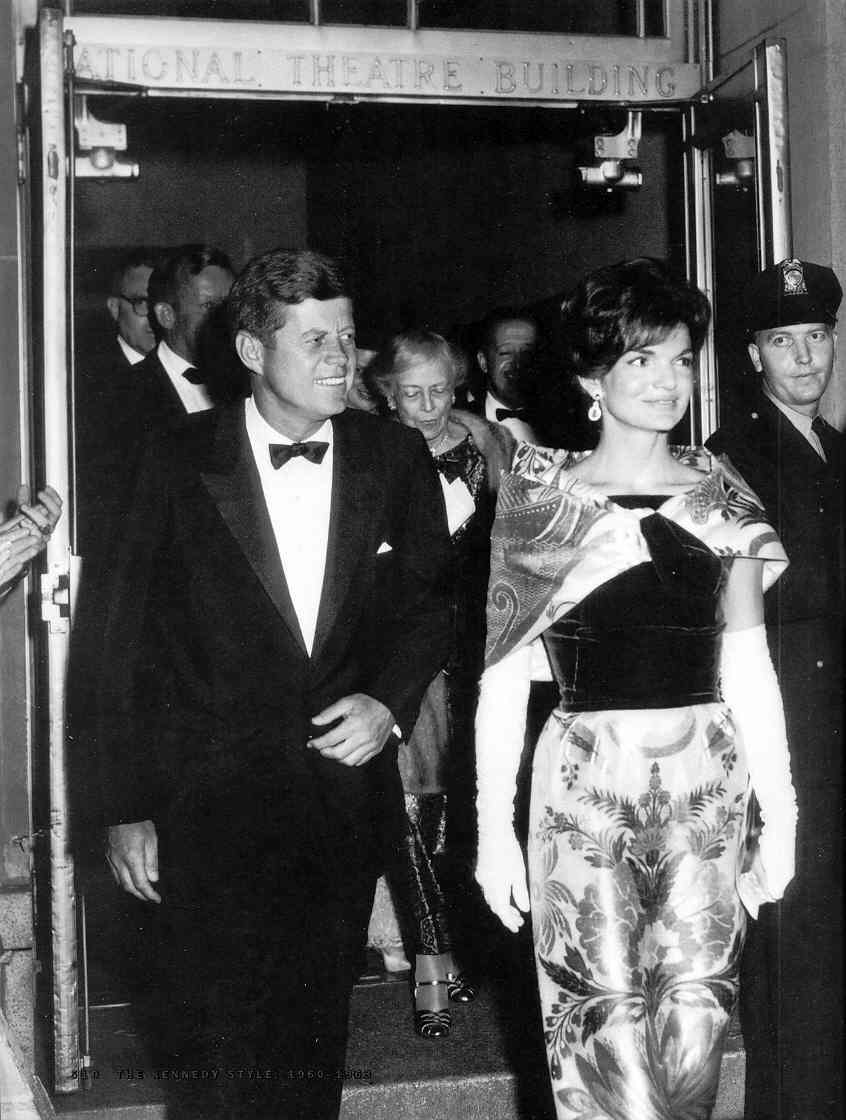
Camelot: the splendor
of the Kennedy's
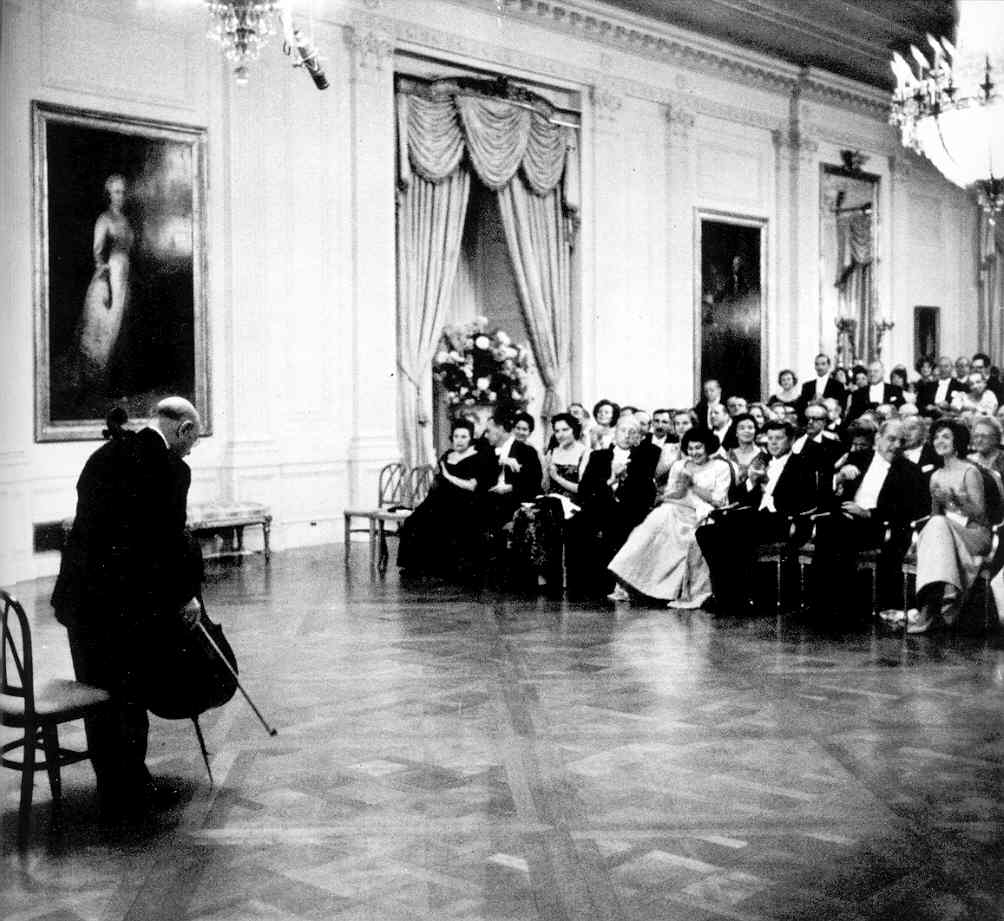
The Kennedy Style:
Pablo Casals performing in the East Room of the White House
KENNEDY AND THE "NEW FRONTIER" |
Kennedy's fondest hope is
to take up the Soviet challenge through a new spirit of cooperation with
emerging nations around
the world: to show them the American way to freedom and development
|
In his Inaugural Address (January, 1961),
at age forty-three, the youngest American to be elected president ever
(following its oldest president up to that time),3
he both explained and personally symbolized the arrival of a regime of
very new ways in which America under his leadership would approach the
challenges then facing the country. He called on Americans to approach
the world in a very new way, to see before them a "New Frontier" both
at home and abroad. America’s youthful spirit (mirroring his own) was
going to revolutionize the world.
He spoke of the immense danger that
nuclear weapons and the arms race posed, not only to the country but
also to the world, and how America needed to back away from these
conflicts and instead take up a more positive approach to the world and
its issues. He called for a new East-West spirit of unity in refocusing
international efforts away from war and directing them instead to the
major problems of poverty, disease, and dictatorship that afflicted the
world. In short, Kennedy called on Americans to look to a more positive
approach to American diplomacy, promising that a better world would
result.
He also spoke his most memorable and
famous line: "Ask not what your country can do for you, ask what you
can do for your country." His call for Americans to take up their
greater responsibilities would find Vets in the audience agreeing
heartily. But that line would make no sense to the rising Boomer youth,
who would approach life in every way possible from exactly the opposite
direction: what does society owe me? But at this point the first of the
Boomer generation were just entering their teenage years, not yet in a
position to turn American culture upside down.
Actually, the New Frontier appeared to be as much cultural as
political. There was something very new about the Kennedy White House
and its social-cultural as well as political impact on the nation’s
capital city, Washington, D.C. Under Truman and Eisenhower, the capital
city had more the feel of a mid-western city, an Indianapolis or an
Oklahoma City. It was all political business, such as there was any
political business to be done. It resembled the many state capitals
around the country. But with the Kennedys in the White House, the city
began to take on a bit of the European character of a London, or
especially a Paris, presided over by a highly sophisticated cultural
elite (involving its non-Puritan morals as well as its artistic
tastes). Under the Kennedys, Washington, D.C., finally became
"fashionable."
Kennedy had been in office only a little
over a month when on March 1st, in pursuit of the ideals declared in
his inaugural address, he issued an Executive Order calling for the
creation of a new program (actually thought up by Senator Hubert
Humphrey) challenging America, in particular its youth, to help spread
the understanding of "The American Way" around the world, by
volunteering as members of a new Peace Corps. University-educated Peace
Corps volunteers were to take their places in the ranks as patriotic
Cold Warriors, not as soldiers, but as cultural missionaries sent out
to show villagers around the world what America was like up close – to
go and live among the people of the Third World in order to show them
personally how American ideals worked to make for a better life.
This would not become a massive,
expensive government program. No huge Washington bureaucracy would
provide the muscle for this program. Instead it would rest on the
support of the thousands of young volunteers who answered the call to
national duty (they did receive the equivalent of army basic pay, which
indeed was truly "basic.")
It was typical of the way that Americans
felt at that time that the nation should go about its business,
challenging the average American to do the right thing, to volunteer to
take up the national cause, just as the nation should inspire (not
dictate to) the world to do the right thing. The Washington
government’s job was simply to organize the opportunities for Americans
to do the right thing, nothing more. Washington itself wasn’t expected
(not yet, anyway) to do the right thing for the people.
The "Silent Generation" respond
Answering the call to Peace Corps service
were thousands of young college grads, members of the very patriotic
Silent Generation. They were quite unlike their younger brothers and
sisters, the Boomers, who would eventually arrive on the political
scene as noisy and aggressive crusaders against virtually everything
their Vet parents held dear. Although this older generation of youth
had been put under some of the anti-authoritarian programming of the
mid-1950s that their younger Boomer siblings had been, these "Silents"
were already in their teens at that point and fairly well developed
along lines much closer to the Vet parents' social values. These were
not rebels but instead idealistic joiners, believing very much in the
American message for the world, and eager to be sent abroad to show
personally to Africans, Asians and Latin Americans the "American Way"
they had grown up in.4
The birth of the hippie counter culture
Ironically the process of cultural
missionary work would however often end up going in the direction
opposite the one intended by the Kennedy Idealists. Many of the
youthful Peace Corps volunteers would "go native" in their two years
abroad, seemingly absorbing as much as or even more than their giving
in the cultural exchange. Many volunteers would return to America
more interested in living close to the soil the way the peasants they
had been living among went about life. The simple life, by
comparison to the complicated life of Middle America, indeed had its
major attractions. And thus many of these idealistic youth would
come to take up the "hippie" communal lifestyle, rejecting the
competitive, upwardly-aspiring Middle-Class lifestyle of their parents,
hoping to find in the communal life a serenity that they felt was
lacking in American culture.
The naive assumption that the world naturally could be, or even always wanted to be, like America
On the other hand, most of the world
stood in envy of American prosperity, its huge material wealth, its
glitzy lifestyle (by comparison to the world’s humble, largely peasant
lifestyle). But envying the American lifestyle and choosing to emulate
that lifestyle, even being able to do so, were two quite different
things.
America could not appreciate the fact
that the Soviet model offered to the political leadership of the Third
World a kind of efficiency or developmental speed in moving from
feudal, agricultural backwardness to industrial dominance in a single
generation (as in Stalin's Russia). American-style capitalism seemed
complicated and required the presence of certain social attributes and
personal skills (especially personal initiative and willingness to take
risks) that just did not exist in these Third World countries.
3Teddy
Roosevelt was younger than Kennedy when he took office as President,
but did so only on the basis of stepping up as former Vice President
into the presidency when President McKinley was shot.
4In
terms of national leadership, this generation will be skipped over, as
presidential leadership would in 1993 pass from the last Vet, George
H.W. Bush to the first Boomer, Bill Clinton, 22 years younger.
Prominent "Silents," born in between those two quite different
generations, would include Newt Gingrich and John McCain – highly
patriotic presidential material ... individuals however who were not
quite able to interest the vote of the Boomers – or the Generation-Xers
that followed the Boomers.
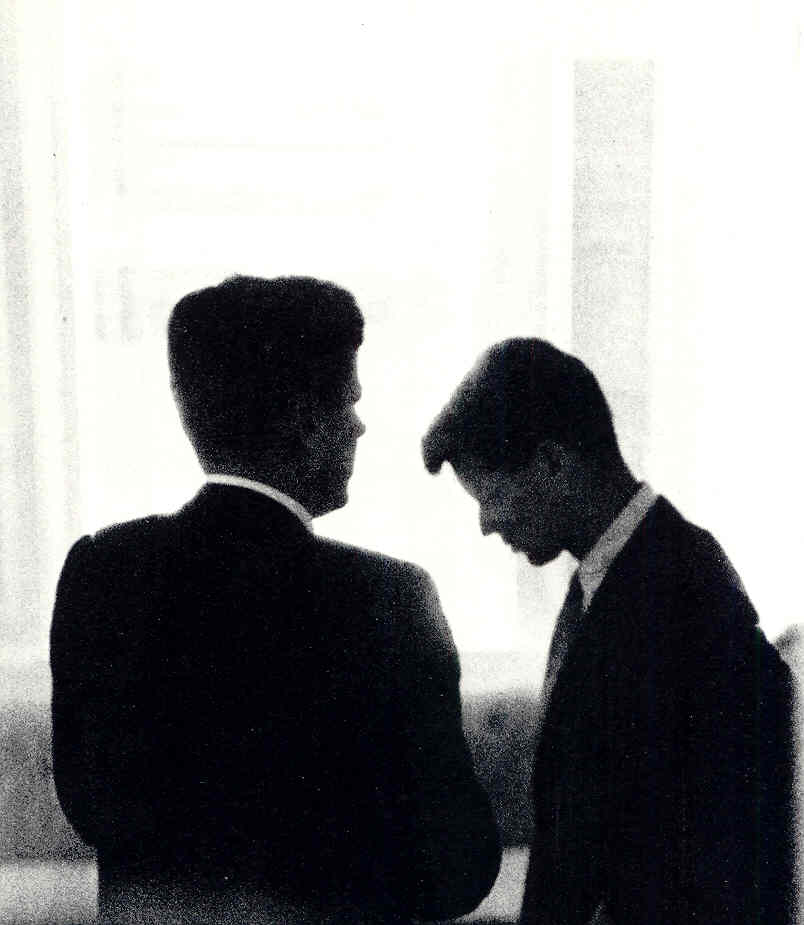
The Kennedy brothers – close
confidants
The US Peace Corps becomes
the symbol of Kennedy's New Look 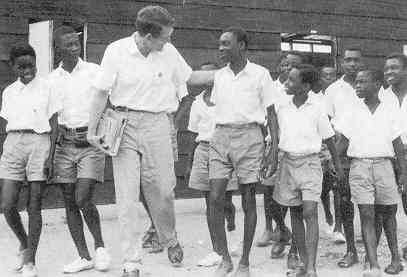
A Peace Corps Volunteer in
Accra, Ghana, with his students
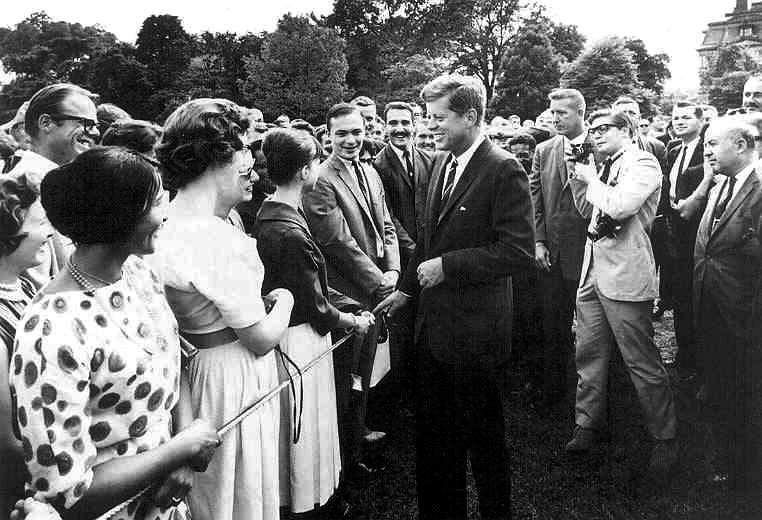
President John Kennedy greeting
Peace Corps volunteers – 1962
THE DISASTROUS BAY OF PIGS INVASION IN CUBA – APRIL
1961 |
Tragically this "new look" is set off
on the wrong foot
by the Bay of Pigs invasion in Cuba – April 1961
|
The Bay of Pigs Fiasco (April 1961)
Almost immediately, Kennedy’s New Frontier
philosophy was put to its first moral test. Kennedy was rather
surprised to learn that a huge 1,400-man militia of Cuban expatriates
had been in training for the eventual overthrow of the troublesome
Cuban President Fidel Castro, and in fact was scheduled for an assault
on Cuba soon after Kennedy took office. The date for the action was
already set for mid-April 1961.
But Kennedy had campaigned on a peaceful
rather than aggressive approach to winning the Cold War contest over
the rising Third World. An American-sponsored invasion of Cuba would
make a complete mockery of that very idea. Yet on the other hand,
Castro was clearly opening up Cuba to massive Soviet influence – right
off the American shores of Florida. Something needed to be done to
reverse that development.
But not seeing any alternative to the plan in place, the new President Kennedy gave the event the go-ahead.
But Kennedy wavered when the involvement
of America was made increasingly obvious. On the third day of the
operation Kennedy called off further American air cover and naval
resupply of the invading militia, leaving the ammunition-less
anti-Castro militia to face the fury of a retaliating Cuban tank corps.
It was a humiliating defeat for the militia, taken prisoners and
paraded in front of the world press. And it was also a grand
humiliation for America, and for the new President, who did not come
away looking anything but weak and irresolute in the face of the Cold
War contest still raging.
Kennedy’s youthfulness thus seemed confirmed not only by his looks but now also by his behavior.
|
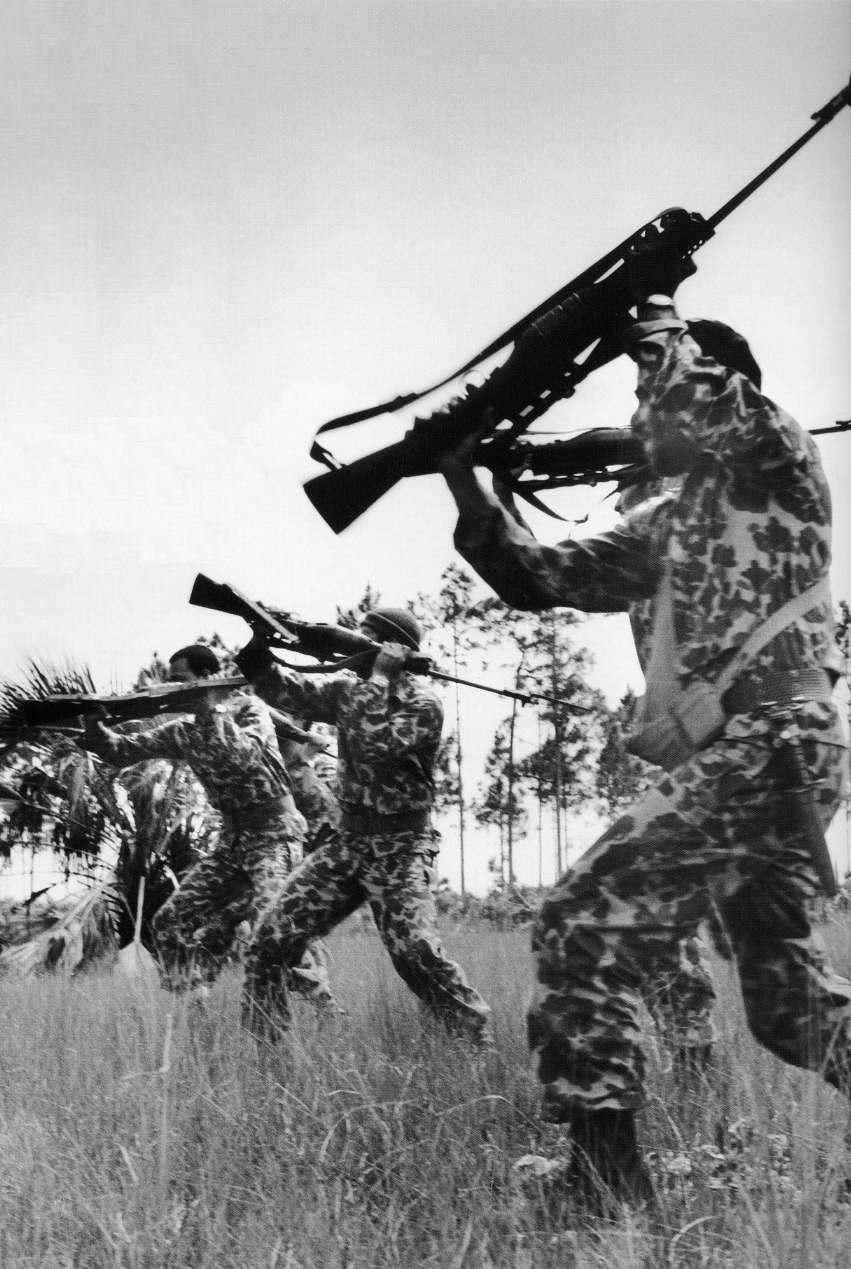
A CIA-sponsored military
training camp for Cubans committed to the overthrow of Fidel Castro (most of these camps were
located in Florida)
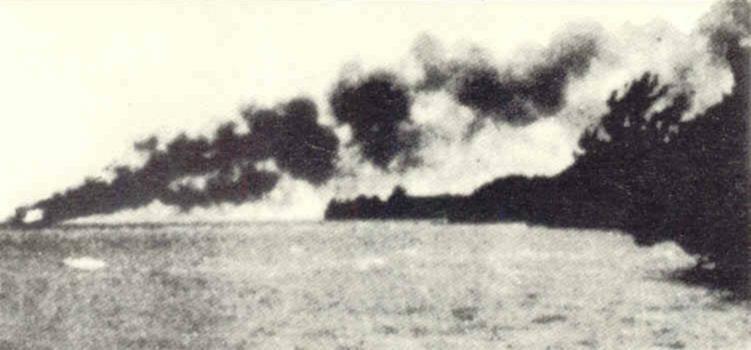
A scene of the military fiasco
at the Bay of Pigs, Cuba – April 17, 1961
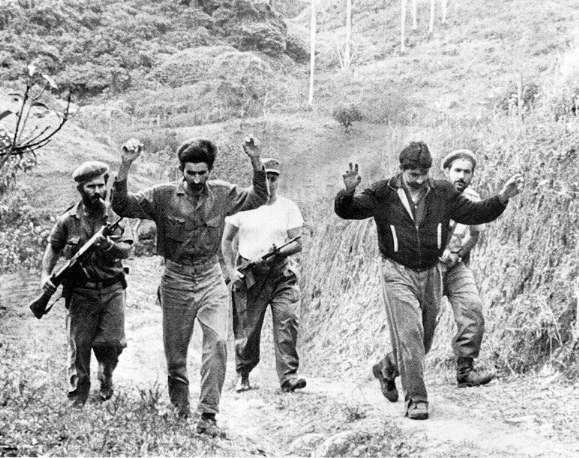
Part of the 1500 member anti-Castro
paramilitaries captured at the Bay of Pigs – April 1961
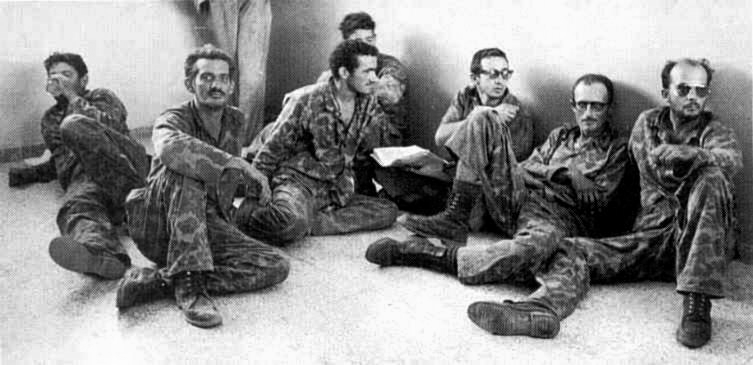
CIA-trained Cuban "liberation"
soldiers captured at the Bay of Pigs
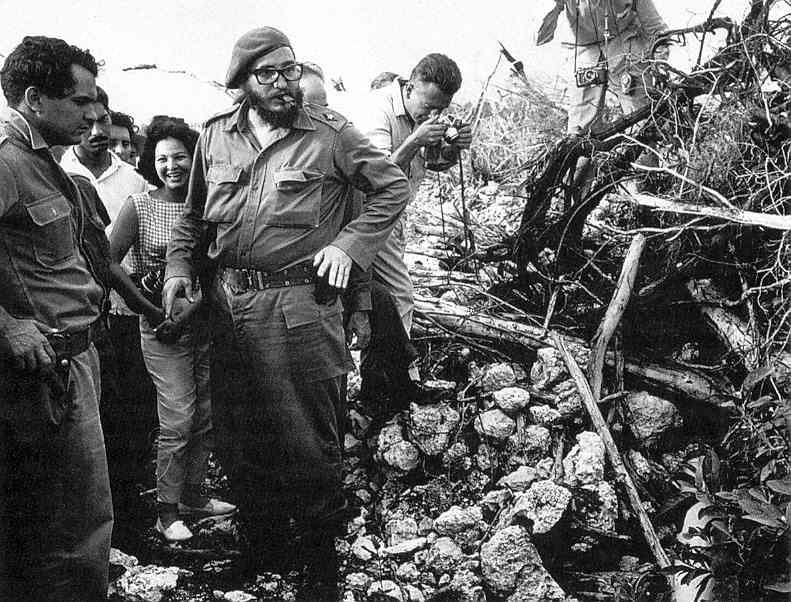
Castro inspects the wreckage
of an American plane that crashed at Playa Giron – April 1961
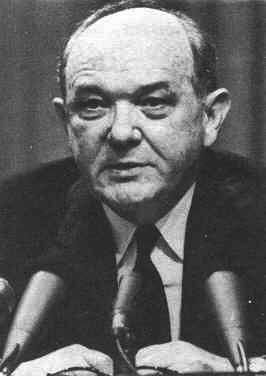
Dean Rusk -
U.S. Secretary of State:
January 1961 – January 1969
|
The latter part of the 1950s saw Europe’s African
colonies wanting to move to national independence. That was not going
to be easy, because when the European powers distributed African
colonial territories among themselves (principally at the Berlin
Conference of 1884-1885), colonial borders were drawn up without any
consideration of the tribal or ethnic lines that divided Africans
locally. Some tribes were divided, with some part of the territory
assigned to the English, some to the French, some to the Portuguese.
Some tribes (even former enemy tribes) were lumped together as part of
this or that European colony. Ultimately what determined the colonial
boundaries had nothing to do with African political dynamics themselves
but instead simply a way of balancing European imperial power by some
kind of equitable assignment of African lands to this or that European
power.
In the very middle of this amazing political arrangement, a huge
section was assigned to the Belgian King Leopold, something of a buffer
between the British, French and German colonies in Africa, much like
Belgium’s assigned role in Europe itself, when the country was set up
in the early 1800s as a neutral buffer territory to keep the French,
British and Germans at some distance from each other.
Now as the 1960s approached, local
leaders (Africans who were European-educated for the most part, but
still identified locally as a member of this or that African tribe)
began to call for the independence of their "nation." Immediately this
threw local African politics into something of a turmoil, as local
Africans saw such a move as merely the opportunity of one tribe to
place itself in a position of dominance over other local tribes
enclosed within these European-created "national" boundaries. For
instance, Nigeria as a nation was definitely more of a British concept
than a local understanding, where local inhabitants of this British
colony saw themselves mostly as Hausa, Fulani, Yoruba, or Ibo – not
"Nigerian."
But in general, the transfer of power
from European to African in the late 1950s and early 1960s was
transacted fairly smoothly, by carefully putting the country’s power in
the hands of a strong local leader, often perceived in America as
simply a dictator, although America generally stayed out of the
process. But it worked, mostly, as these new "nations" were granted
independence and took their seats as new members of the United Nations
Organization.
The Belgians themselves were in no hurry
to grant independence to their Congo colony, Belgium being deeply
invested in the economy of its colony. But the process of gradual
introduction of local self-rule in 1957 simply opened the realm of
rapidly-rising expectations that always accompanies a shift in the
political status quo.
Patrice Lumumba attempted to push a "national" political organization
he headed as the logical group to take over an independent Congo,
drawing the opposition of other Congolese personalities. Further, his
Socialist attitudes concerned the Belgians greatly about their ongoing
economic position in a post-independent Congo under Lumumba.
But when deadly violence broke out in the
Congo, the Belgians, hoping to calm the situation, moved fairly quickly
to grant full independence to their colony at the end of June (1960).
But this was only the beginning of the violence, for there were some
80,000 Belgians living in the Congo and local groups turned violently
on these Europeans (similar to the treatment of Europeans in Dutch
Indonesia and French Algeria). The United Nations was called in to help
protect the Belgians, who at this point were scurrying to get out of
the country.
In their departure, the Belgians gave
over their Congo colony in June of 1960 to a hopeful coalition of local
Congolese leaders supposedly constituting a new Republic of the Congo.
But this was the signal for a wide number of individuals, usually
supported by a local tribe, to attempt to either take control of the
new government – or simply try to break free from the new Congo and set
up their regions as independent countries. To keep the Congo unified,
Lumumba turned to the Soviets (who thus sent 1,000 military "advisers"
to the Congo), alarming greatly the Americans. Meanwhile the Belgians,
trying to keep some kind of foothold in the Congo, threw their support
to mineral-rich Katanga Province leader Moise Tshombe.
At this point U.N. troops were also
trying to keep the country from falling apart. However, as the
situation failed to improve with time, U.N. Secretary General Dag
Hammarskjöld tried personally to intervene, only in flying to Africa to
have his plane crash (September 1961). Things then got even crazier.
America then swung its support to
Tshombe, convincing him not to separate the Katanga Province from the
Congo but instead to take over the whole of the country (1963). This he
did, settling things down (sort of) under his rather dictatorial rule.
But Tshombe’s military commander Mobutu Sese Seko in 1965 decided that
it was time to step in and take control of the country (whose name he
changed to Zaire in 1971). Mobutu would remain firmly in power all the
way up until his death in 1997!
Lessons for America in African politics
America got nothing out of the Congo
crisis – except the understanding that there was very little America
was likely ever to get out of African developments. In a sense Africa
was Europe’s huge legacy. And whatever developed on that continent,
especially in the Sub-Saharan or southern part of the continent, was
Europe’s concern, not America’s. African countries were likely to be
run by tribal dictators anyway. And America (other than, in a limited
cultural way, its talented Peace Corps volunteers) would have no way of
influencing the very strong political instincts of the African people.
|
SOUTH AFRICA'S ETHNIC DISPUTES |
|
The exception to this political hands-off policy
would be the country of South Africa, long run by Dutch and
English-speaking Whites. Much more was expected by Americans of those
European descendants in their handling of South African politics. But
those expectations were based on an amazing ignorance of any of South
Africa’s actual social dynamics.
The Dutch had actually moved into a
sparsely settled South African Cape region back in the 1600s – just as
the English were colonizing the sparsely-settled shores of North
America. And this Dutch settlement in South Africa occurred also at
precisely the same time as other Dutch were settling into the Hudson
River, Manhattan, and Long Island region of what would eventually
become New York!
Somehow America, however, seemed to miss
the comparison between these Dutch South African settlers who came to
see themselves as "Afrikaners" and the Anglo settlers of New England
and Virginia, who would eventually see themselves as "Americans."
Indeed, 20th century Americans simply viewed the Dutch-speaking
Afrikaners (and the later-arrival South African Anglos) as illegal
occupants of a Black African continent.
Actually, the tall Bantu Black Africans
(mostly of the Xhosa and Zulu tribes) in their migration south along
the Indian Ocean were themselves later arrivals to South Africa. And it
was not until the mid-1700s that the two groups, Bantu Blacks and
Afrikaner Whites, met – much to each other’s surprise! – about halfway
across what is today South Africa.
The original inhabitants of South Africa
were not the Bantu but instead the San people (Bushmen and Hottentots),
hunted like rabbits by the advancing Bantu. The San survivors took
refuge among the more hospitable Dutch, learned their language, and
today forming the Dutch-speaking "Coloured" ethnic component of South
Africa – the descendants of the original but largely forgotten
inhabitants of the region.
But Americans simply chose to see all
this South African dynamic as another version of its own growing
Black-White problems arising at home in America, totally missing the
complexities of the South African situation – a situation just about as
complicated as any other of Africa’s political situations. For
instance, the ancient hatred between the Bantu Xhosa and the Bantu Zulu
was intense inside of the country, but overlooked entirely by the
outside world that saw only "Black" and not Zulu or Xhosa. Then there
was the matter of the huge Indian population of South Africa’s Natal
Province – where Gandhi himself had practiced law for twenty-one years
before heading off to India to save that country from the British. Few
Americans had any idea that this huge Indian population even existed in
"Black South Africa." And of course the White community itself was held
together in a very precarious Dutch-speaking and English speaking
union, in which the English seemed to have less an emotional foothold
in the country (arriving at South Africa two centuries after the Dutch
had made it their home) and thus more willing to be compliant before
rising Black political expectations for mastery of "their African
nation." To the Dutch-speaking Afrikaners, however, South Africa was
certainly no less "theirs" than it was to the late-arriving Bantu.
Anyway, Americans eased their own
consciences deeply shamed by White mistreatment of Blacks in America
itself – by becoming super zealous in attacking White South Africa for
its "similar" racial prejudices. The fact that the South African and
the American situations had little in common did not seem to matter, nor
did it even stir the curiosity of Americans as to what was actually
happening in South Africa. The Americans were well-pleased to keep the
South African moral matter as simple as possible. Thus they could
pronounce their own judgments on South African developments with a very
clear (actually very muddled) conscience.
Ultimately this served no one well, particularly the South Africans.
|
THE SOVIETS LAUNCH THE FIRST MAN INTO SPACE –
APRIL 1961 |
The Bay of Pigs fiasco is
timed with another American setback: the Soviet's announcement
that they have launched the first man into space – April 1961
The Soviets continue to push
ahead in the space race with a number of new "firsts"

Yuri Gagarin, first man in
space, April 12, 1961
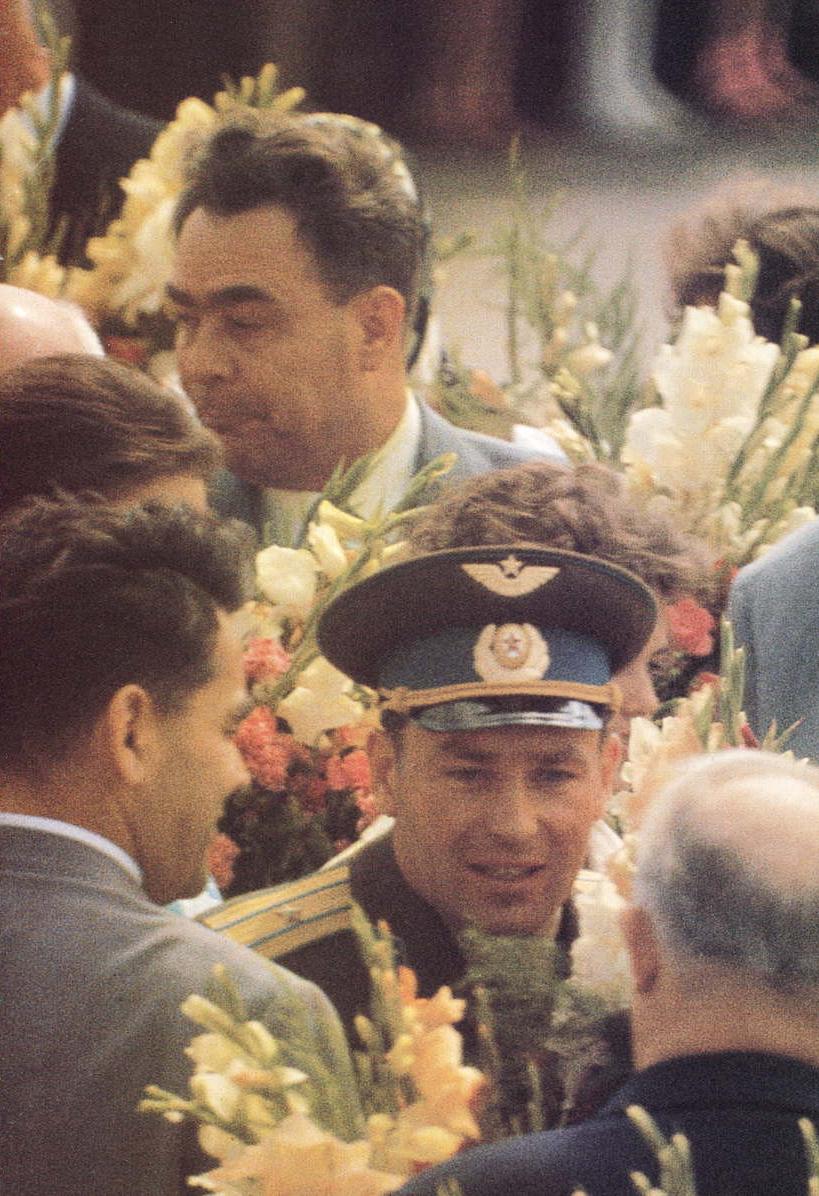
Yuri Gagarin being greeted
in Moscow by Khrushchev
two days after his 89-minute
flight into space – April 1961
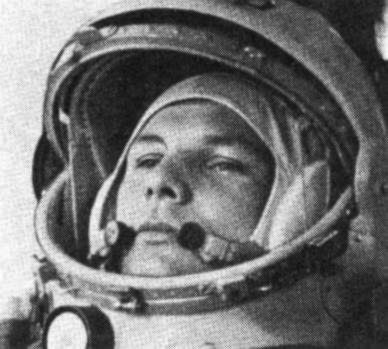 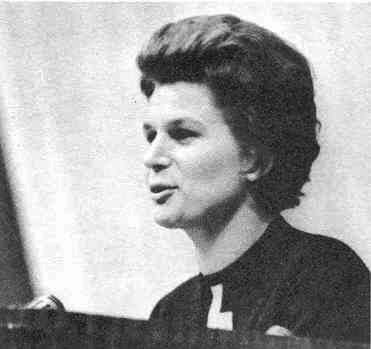
Russian cosmonauts Yuri Gagarin
and Valentina Tereshkova – first man and first woman in space
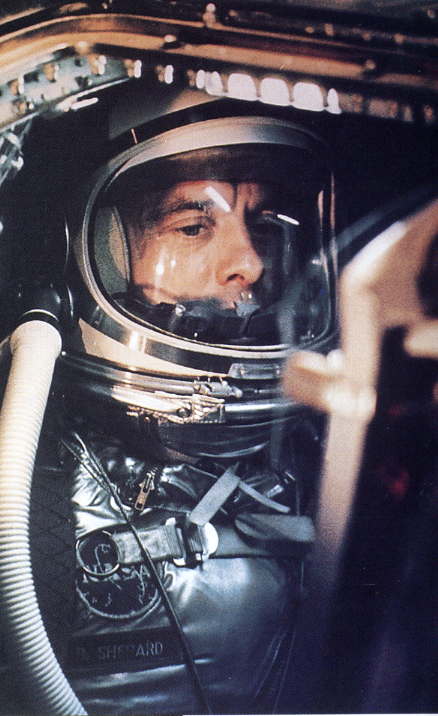
Alan Shepard, Jr. – 1st American
into space – May 1961 (but unlike the Soviet flight
of Gagarin, Shephard did not orbit the earth)
THE FAILED EAST-WEST SUMMIT IN VIENNA – JUNE 1961 |
In June of 1961 the Kennedys travel
to Europe in an effort to improve relations with a distancing France and a threatening
Russia
|
Soviet premier Khrushchev had indicated quite
clearly that the Soviets were going to push harder in aligning the
rising Third World with the Soviet bloc, Castro’s Soviet-supported
social revolution in Cuba and the chaos in the Belgian Congo's
independence serving as examples of what America might expect from the
Soviets.
At the same time, Khrushchev announced a
coming treaty with East Berlin, one which would end access rights from
East Berlin into West Berlin.
To try to defuse resurfacing Cold War
tensions, Kennedy got Khrushchev to agree to a summit meeting in Vienna
in June. But dealing with Khrushchev would not be a straight-forward
matter. Kennedy was warned about Khrushchev’s very aggressive
style, even by French President De Gaulle whom Kennedy visited on his
way to Vienna.
Ultimately the Vienna meeting did not go
as Kennedy had hoped and, possibly even worse, confirmed Khrushchev‘s
impression of Kennedy as a weak leader. The Soviet closing of open
access to West Berlin thus moved forward as planned, despite Kennedy’s
own announcement of a considerable beefing up of American NATO support
in Germany.
|
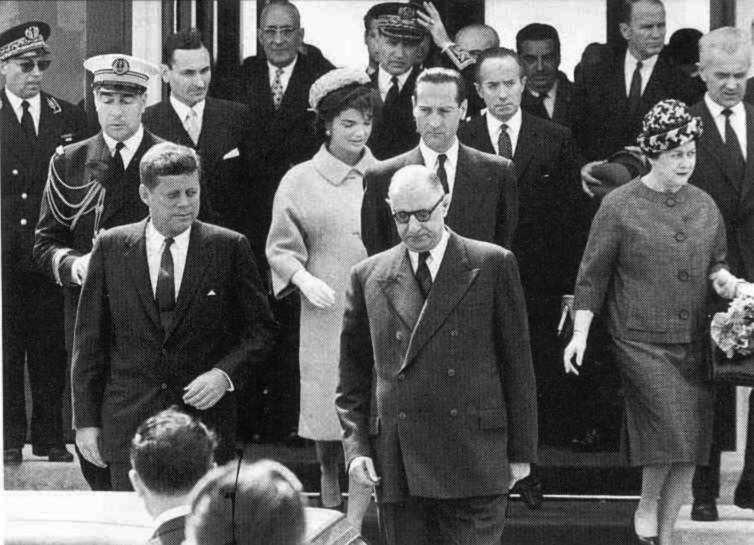
The Kennedys with Charles
de Gaulle outside the Elysee Palace – June 1961
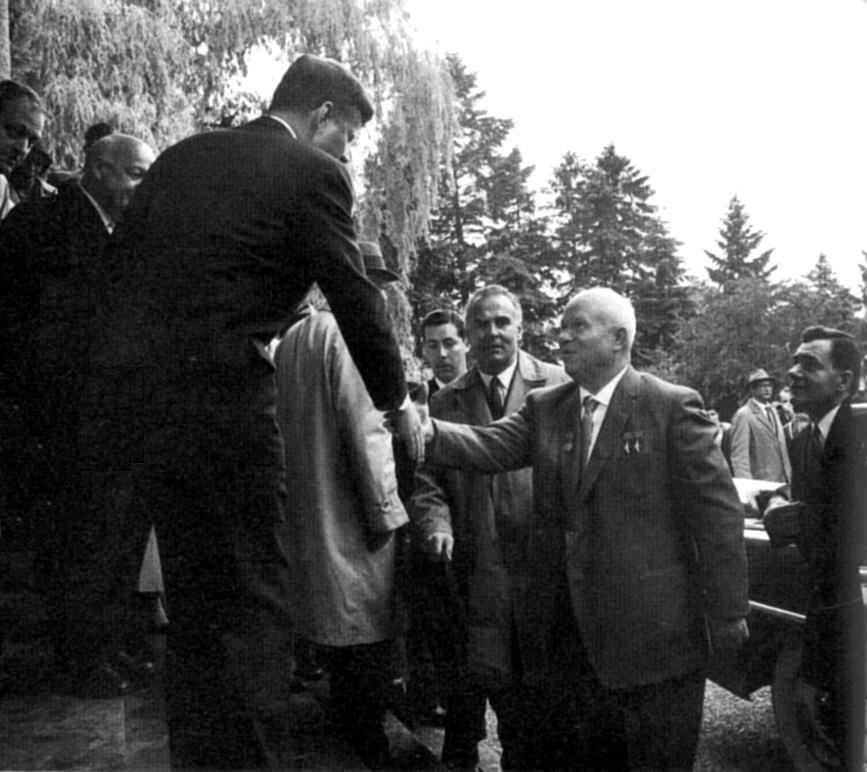
Kennedy Greets Khrushchev
in Vienna – June 3, 1961
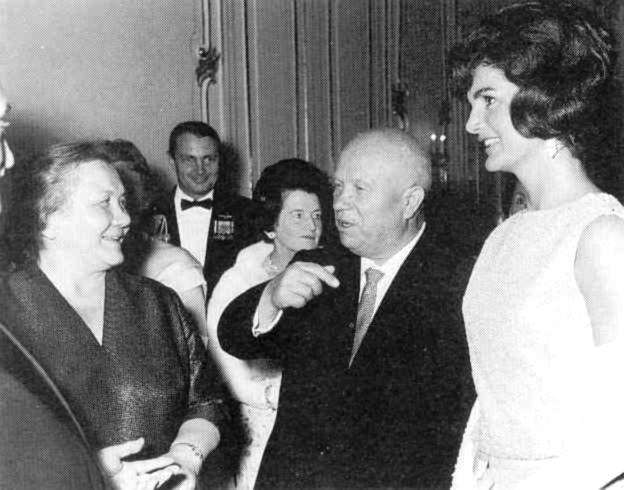
Nina and Nikita Khrushchev
chatting with Jackie Kennedy in Vienna – June 1961
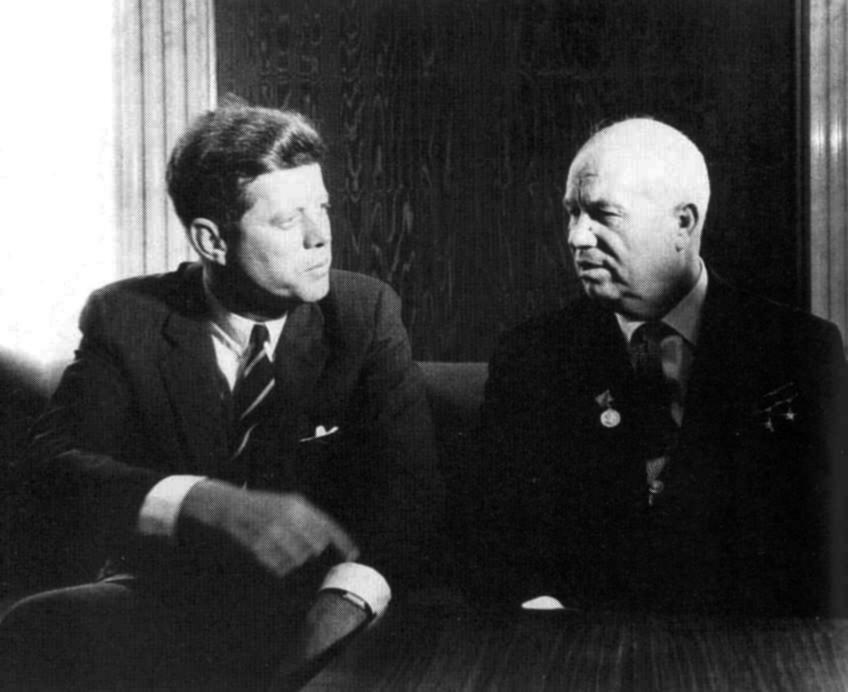
In his "summit" meeting with
Nikita Khrushchev (June 1961) Kennedy becomes aware that a new test of East-West
resolve is about to occur over Berlin
THE BERLIN WALL GOES UP – AUGUST 1961 |
|
In the next weeks, tens of thousands of Germans
poured from East Berlin into West Berlin in anticipation of the Soviet
closing of access from East to West Berlin. Finally in mid-August East
German soldiers began the erection of at first a barbed-wire then a
concrete barrier (ultimately including armed guard towers and
minefields) around West Berlin, closing off all further access from the
East to the West of the city. The last open door offering escape from
the Soviet side of the Iron Curtain was now completely closed.
Much of the world watched in anticipation
to see what Kennedy would have the Americans do in response. It soon
became apparent that there would be no American response in terms of
knocking down the wall. But Kennedy did make it a point to march NATO
troops to West Berlin using the highway running through East Germany,
daring the Soviets to try to block the continuing access of Western
troops into West Berlin.
|
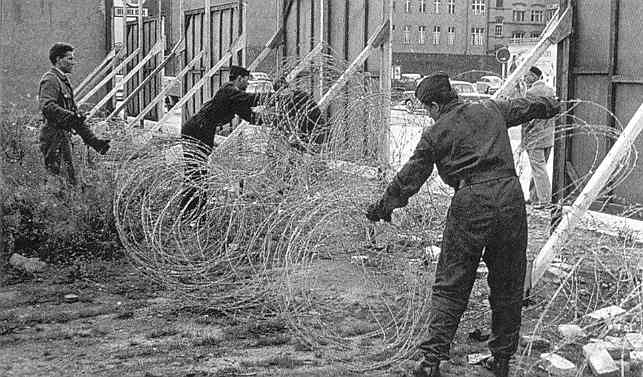
Barbed wire going up quickly
around Berlin – August 1961
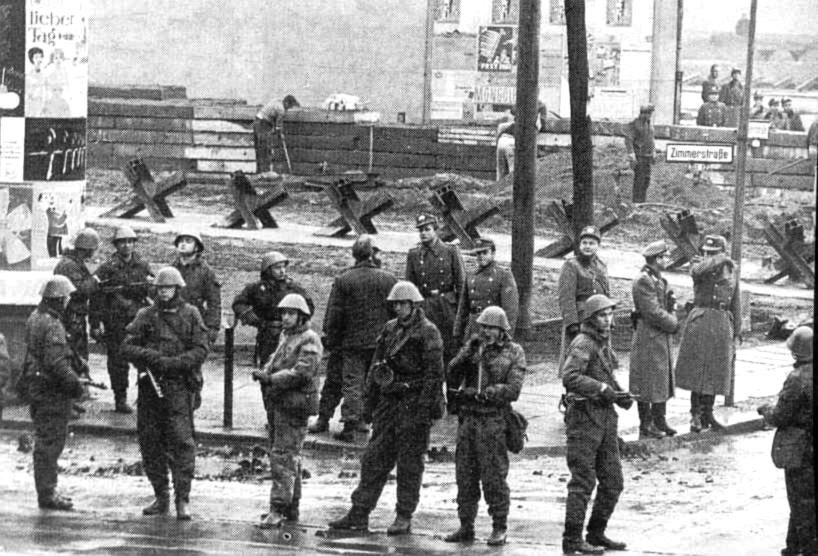
An East-West standoff over
the Berlin Wall – August 1961
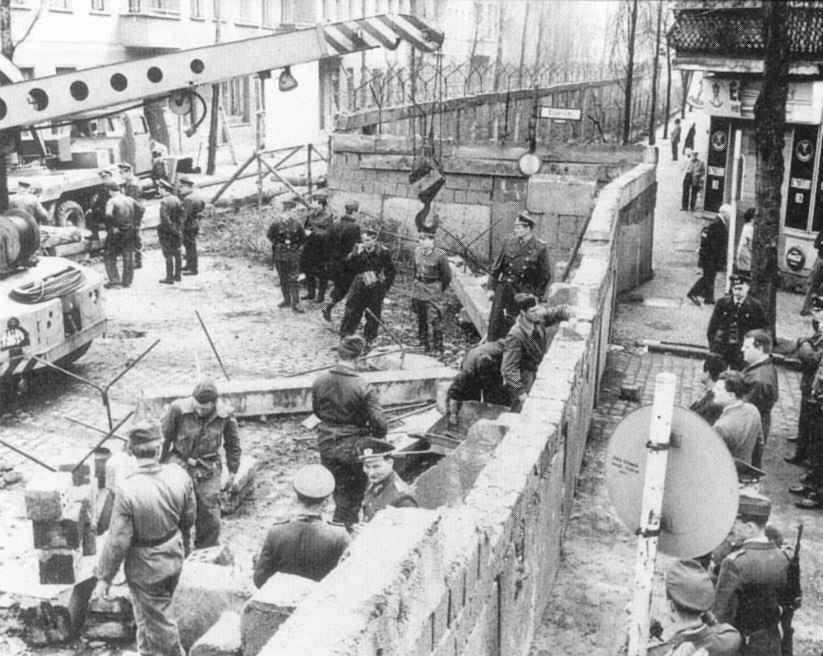
Watching East Germans put
the finishing touches on their own imprisonment
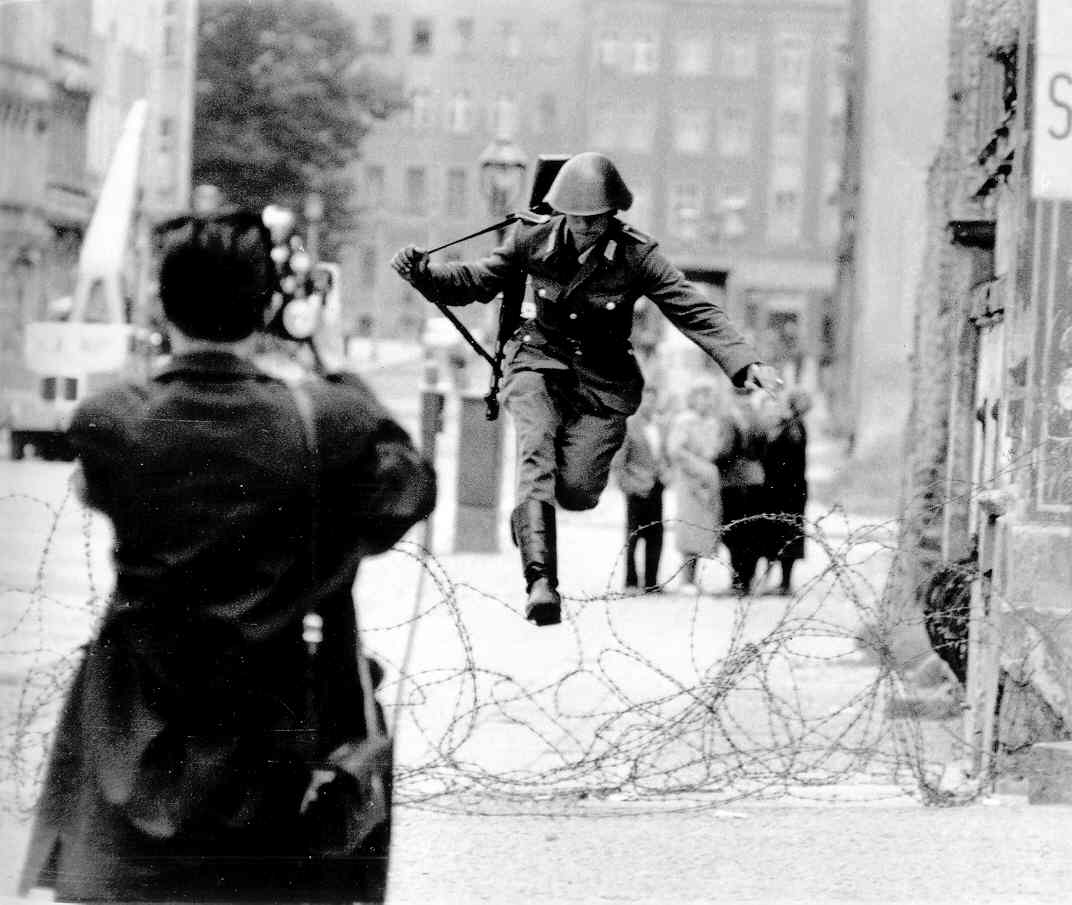
East German border guard
escaping to the West – August 13, 1961
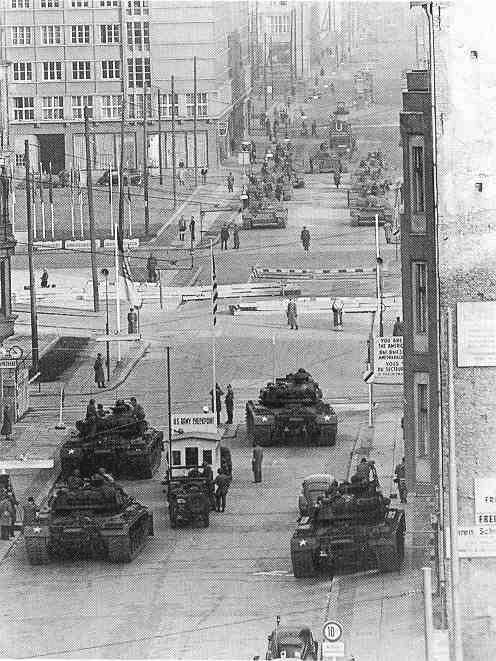
Soviet-American tank standoff
at Checkpoint Charlie in Berlin – October 1961
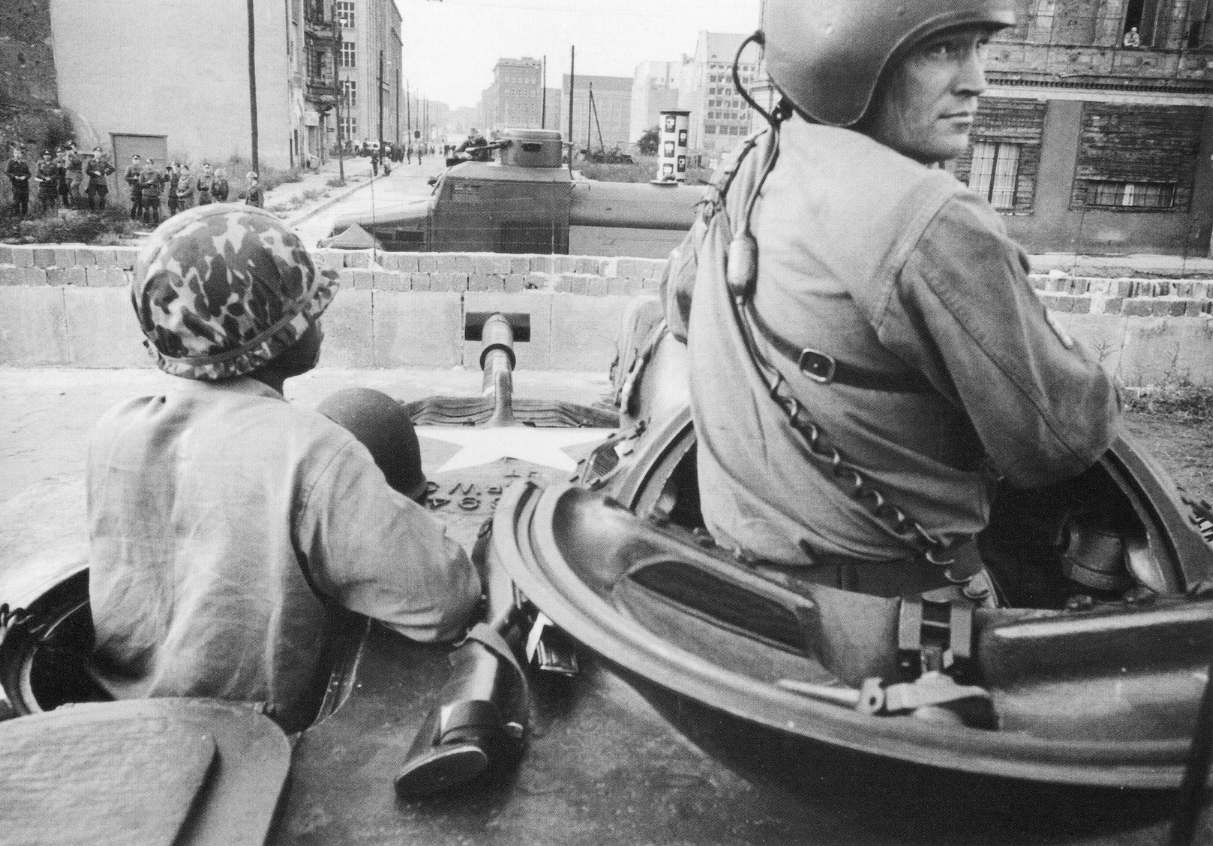
Stand-off at the new Berlin
Wall – 1961
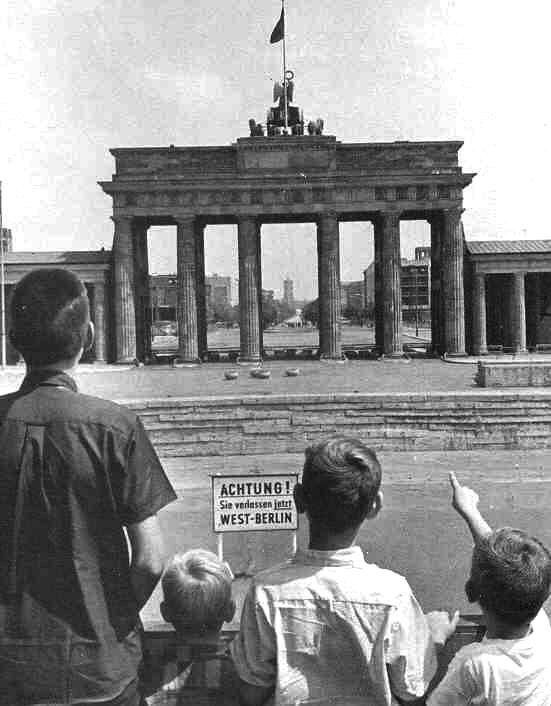 The Brandenburg Gate and
the Berlin Wall
The Brandenburg Gate and
the Berlin Wall
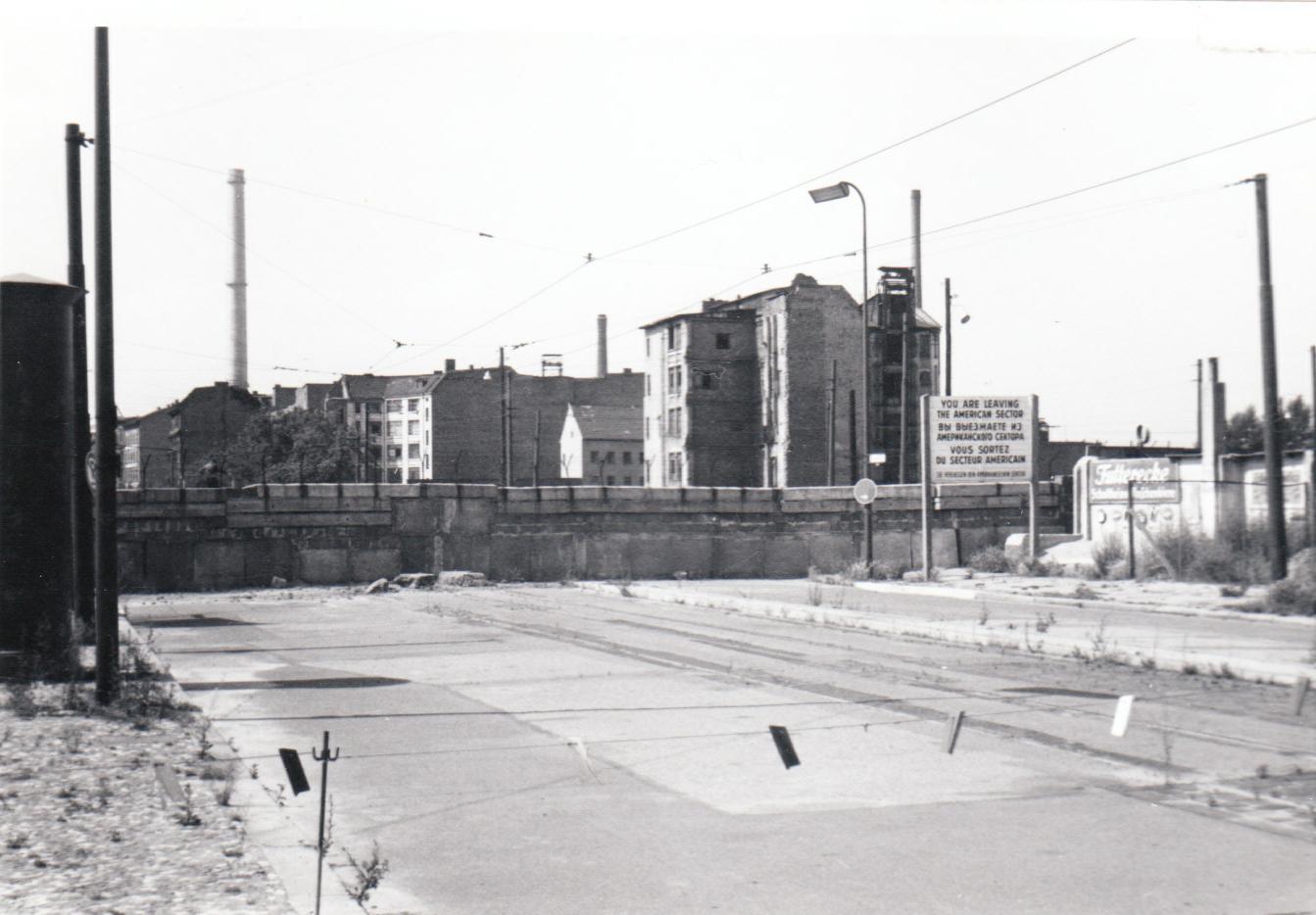
The Berlin Wall – July
1962
Miles Hodges
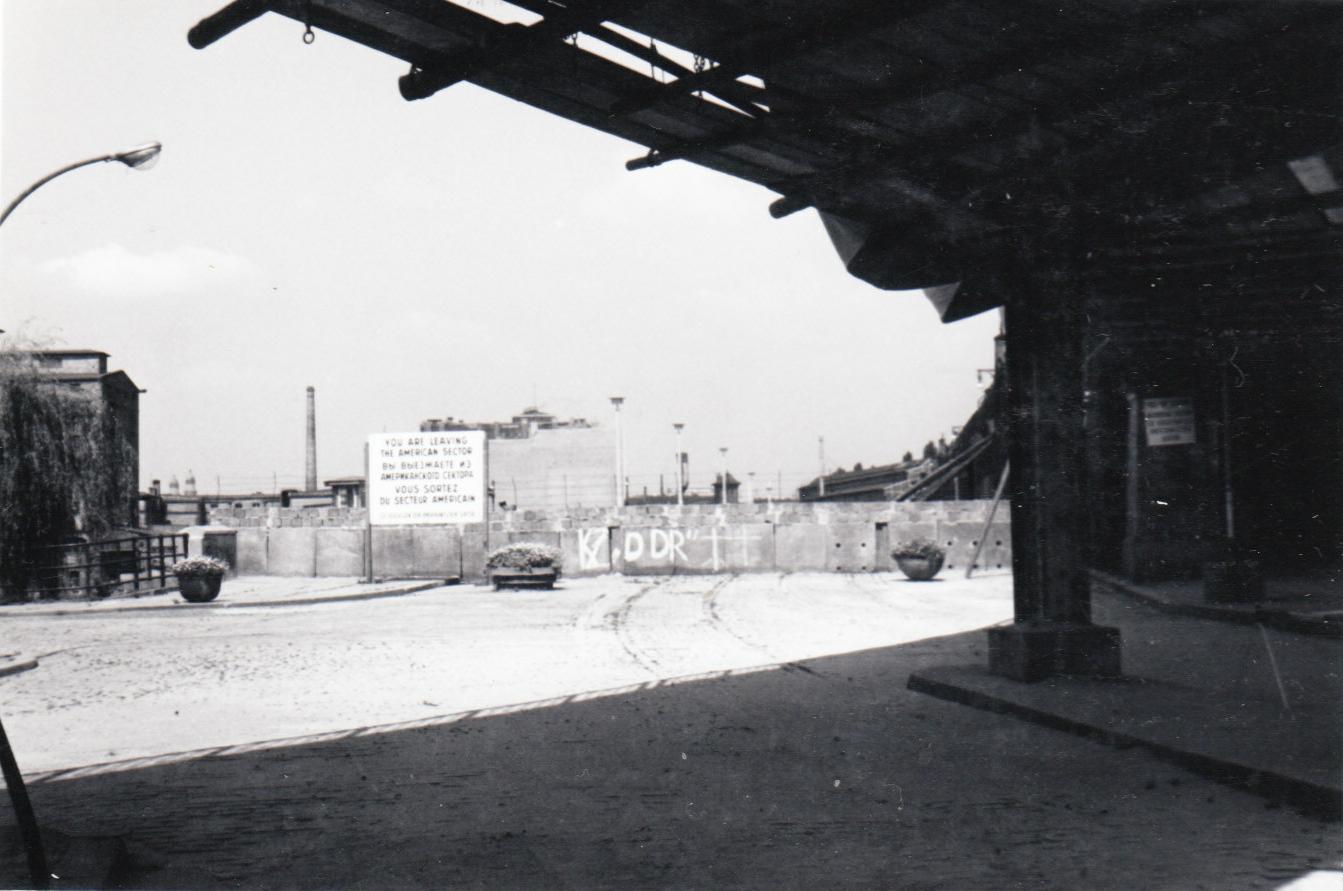
The Berlin Wall – July
1962
Miles Hodges
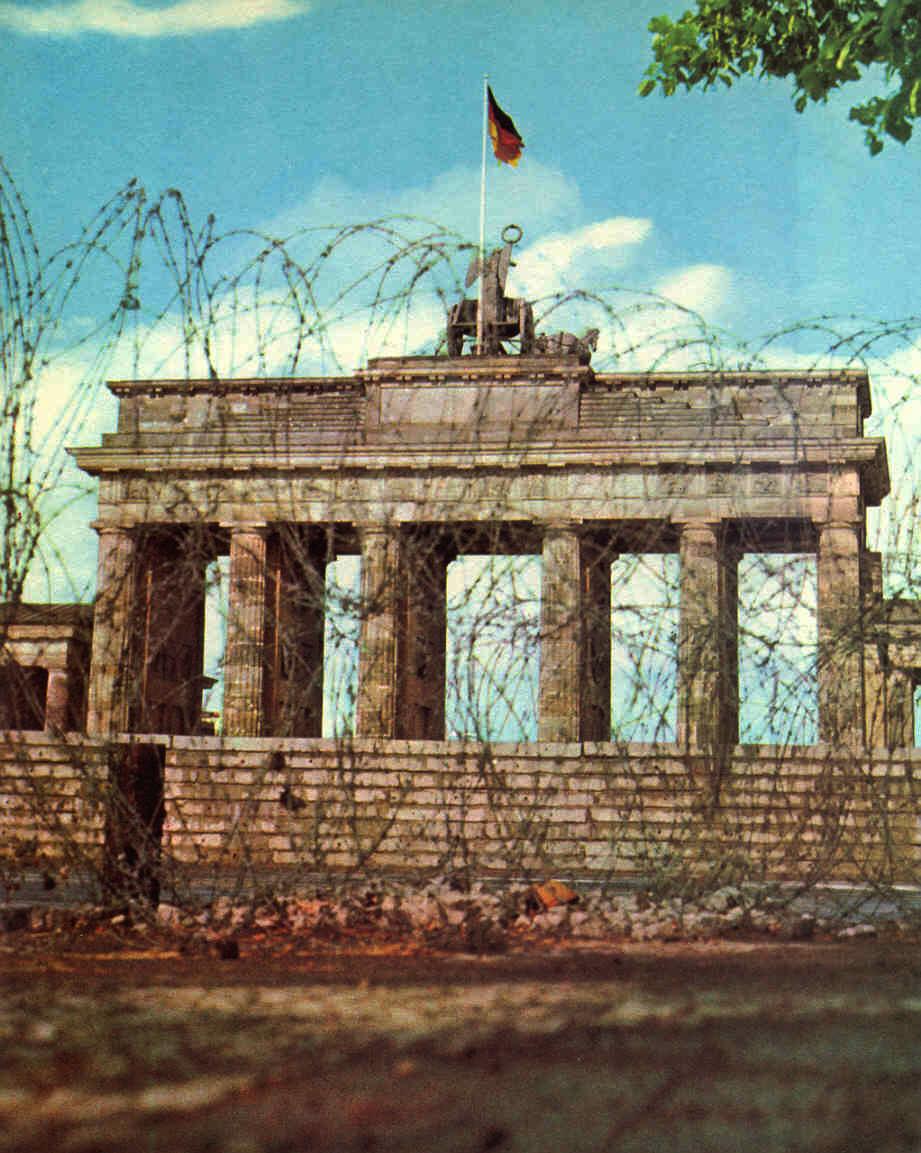
The Berlin Wall as it passes
before the Brandenburg Gate (29 miles long and 8 to
12 feet high)
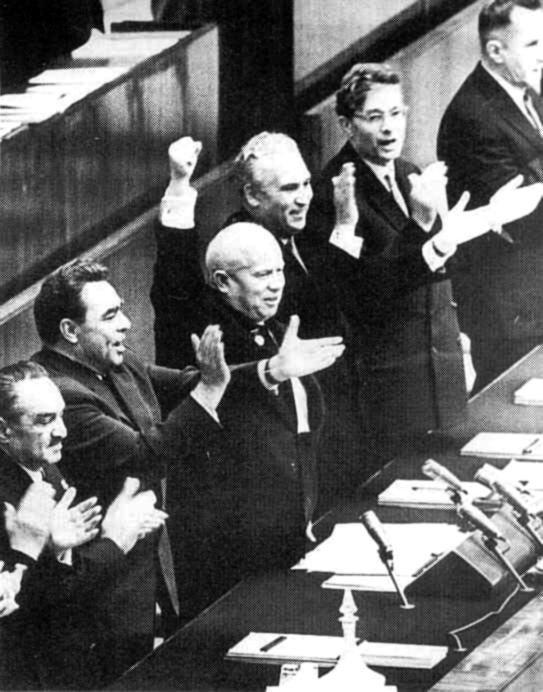
Khrushchev being applauded
at the 22nd Party Congress in Moscow – October 1961
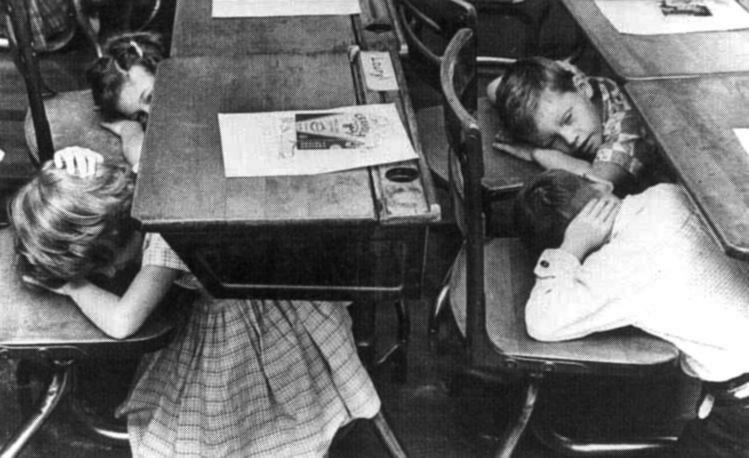
American children practicing
"duck and cover" drills as Soviet American tensions build, and Americans come under a new fear of
a possible nuclear war with an aggressive Soviet Union
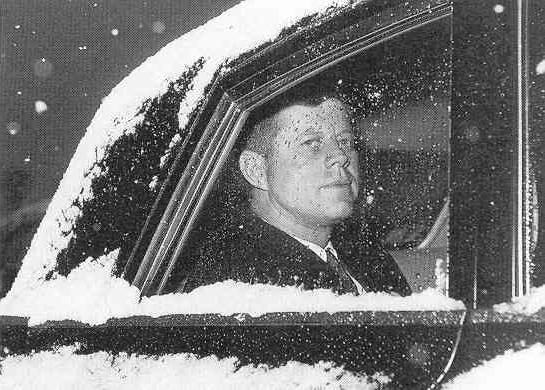
Kennedy finishes out the
first year of his presidency as a very tired man – December 1961
THE CUBAN MISSILE CRISIS – OCTOBER 1962 |
The weak Kennedy response
to Soviet challenges emboldens Khrushchev to try to plant deadly nuclear
missiles in nearby Cuba – October 1962
|
Despite the abysmal failure of the Bay of Pigs
invasion, Kennedy and the CIA had not ceased to plan to remove the
Cuban threat posed by Castro’s Communist regime, and had undertaken a
number of programs to isolate Cuba economically and destabilize the
regime internally. These plans included a revolt within Cuba by
disaffected Cubans (Operation Mongoose), supported of course by U.S.
funding.
Castro and Khrushchev quite naturally
suspected such a U.S. maneuver, and Khrushchev saw an opportunity not
only to thwart this operation, but to embarrass and weaken further the
American international position by placing nuclear-tipped missiles in
Cuba, ones possessing fully a first-strike capability. This could be
used as leverage to force America to back down, not only in the event
of an American attack on Cuba but even elsewhere if need be – such as
in the event Khrushchev wanted to try again to force the West
completely out of Berlin. Placing Soviet missiles in Cuba would also
neutralize the impact of the American nuclear missiles placed in Turkey
and aimed at the Soviet Union.
By the summer of 1962, Castro had come to
the point of accepting this idea of placing Soviet missiles in Cuba,
seeing in this the further securing of his own position not only as
Cuban leader but also as a major sponsor of social revolution elsewhere
in the Western Hemisphere.
Within the Soviet hierarchy in Moscow
itself there was considerable debate about the wisdom of such an
aggressive move against America, as the Americans, compared to the
Soviets, had a vastly greater number of long-range nuclear rockets and
nuclear warheads (over 15 times the number of Soviet warheads) able to
do widespread damage in case of a Soviet-American conflict. But
Khrushchev was able to carry the day on the basis of his portrayal of
Kennedy as a weak individual who would be forced to accept the Cuban
missiles rather than take direct military action that would provoke
all-out war. The net result of Soviet missiles based in Cuba would thus
be a massive shift in the international balance of power in favor of
the Soviets.
Preparations thus got underway to first
build the infrastructure of the launch sites where these Soviet
missiles could be based. It would all be done in high secrecy of course
– until the missiles were fully operational.
But American U-2 spy-plane flights over
Cuba soon detected the infrastructure activity in Cuba (August) and
complained – but received from the Soviets in early September the
assurance that the installations being placed in Cuba were purely of a
defensive nature. But that merely raised the question within the
American intelligence community as to why defensive (short range)
missiles were necessary unless they were designed to protect something
of greater strategic importance, such as long-range missiles aimed at
the US.
Actually, at the same time that the Soviets were assuring the world
that their plans were merely to enhance the defenses of Cuba, the first
of a number of Soviet R-12 medium-range offensive ballistic missiles
capable of delivering nuclear warheads well over 1,200 miles were being
delivered to nine bases in Cuba. And R-14 missiles with a range of
2,800 miles were being delivered to three additional bases. Once
operational, some forty launch points would put most of the U.S. under
the threat of nuclear attack.
At the same time, fearing that defensive
missiles might be used to bring down another American U-2 spy plane,
further U-2 flights over Cuba were canceled. But American defense
analysts were concerned that the configuration of these Soviet sites
matched those of major nuclear sites within the Soviet Union itself,
and finally got U-2 missions resumed a month later – although it was
not until mid-October (the 14th) that the cloud cover over Cuba broke,
allowing the Americans to detect finally what was really going on in
Cuba.
The next day President Kennedy was
informed of the problem, and the day after that Kennedy convened his
national security team to discuss the situation and consider the
American options, none of which were very good. Some, such as Kennedy’s
Secretary of Defense Robert McNamara, argued that the small number of
Soviet missiles placed in Cuba would not affect the balance of power
significantly. But others argued that failure to act would further
weaken the appearance of American power and undercut the reputation of
America as a reliable defender of its NATO partners, especially just
after Kennedy had promised the American people publicly that America
would act decisively in case the rumors already in the press concerning
nuclear missiles being placed in Cuba were proven to be true. But what
would constitute decisive action?
At a meeting on the 18th between Kennedy
and Soviet Foreign Minister Andrei Gromyko, the Soviets again made the
claim that the sites were just for defensive purposes, not knowing that
the Americans already knew this to be quite untrue. Thus there was
nothing yet to be done diplomatically, as long as the Soviets continued
to play this hand of innocence. But still, direct military action?
Finally on the 21st, the decision was
made to throw a U.S. naval blockade around Cuba, under international
law an act of war, but not sufficiently provocative to push Khrushchev
to start a nuclear exchange. Further, the next day (the 22nd) the large
inter-American alliance of the Organization of American States (an
alliance founded in 1948 uniting thirty-five countries of the Western
Hemisphere) was called to invoke the terms of the defense treaty, and
the OAS gave its support of the "quarantine" idea when the crisis was
explained to the organization. This isolated Cuba considerably
diplomatically, as well as Soviet Russia, which had long wanted to
improve its diplomatic position among the Latin American countries.
Also that same day, leaders of America's European allied nations gave
their approval to the idea of the blockade.
Then that same evening (again, on the
22nd) Kennedy was ready to address the nation on television, explaining
the nature of the Cuban missile crisis and the American decision in
response to it.
The next days were filled with all sorts of talk and speculation back and forth everywhere.
It was at this point that the idea of
dismantling American Jupiter missiles placed in Turkey in exchange for
the dismantling of the Soviet missiles in Cuba was discussed. Turkey
was most unhappy at the possibility, even though the missiles located
there were, by the technological standards of the day, relatively
obsolete – and American nuclear-armed ships positioned in the Eastern
Mediterranean were more than able to compensate for the withdrawal of
the missiles from Turkey. But for the Turks this was a matter of the
appearance of a reduction of American power in support of its ally
Turkey.
Meanwhile the American naval blockade was
put into place, and the first ships headed for Cuba were intercepted –
but were allowed to continue onward when it was observed that they were
carrying no strategic war materials to Cuba.
Nonetheless, the Soviets were not backing down, and development of the
launch sites in Cuba continued. And Castro, becoming more certain that
an American offensive was about to be undertaken, on the 26th called on
Khrushchev to issue a pre-emptive nuclear strike against America, even
if only the short-term missiles able to reach no further than Miami
were operational at that point.
But that would most certainly mean that
America would strike back, not only at Cuba (probably destroying the
island) but starting an all-out nuclear war with the Soviets.
Cuba was not that important to the
Soviets however, and on the 27th Khrushchev addressed the world over
Radio Moscow announcing a willingness to remove the Soviet missiles
from Cuba – if the U.S. did the same with its missiles in Turkey.
Castro was furious at this offer, issued by Khrushchev without first
consulting with the Cubans themselves. But there was little Castro
could do at this point. The game was entirely out of his hands. But it
appeared that he was fully ready to see Cuba destroyed, if only it
meant that America too (and much of the rest of the world) would be
destroyed.5 But this is where Castro and Khrushchev parted company.
Then on the same day, an American U-2
plane was shot down, the Russians blaming it on the Cubans (although
only the Soviets had the capabilities to do this). At this point
the Americans were furious, and warned that if another plane were shot
down the U.S. would be compelled to attack all the missile sites
(Russian technicians as well as Cubans caught in the attack). Now
Khrushchev was beginning to believe that the Americans were truly
serious about ending this matter.
But then that same day (the 27th) the
Kennedy team decided to formally accept Khrushchev’s offer to
demobilize the Soviet missiles, not mentioning specifically the Turkish
exchange, but quietly implying that this would happen on a "volunteer"
basis. On the 28th, Khrushchev, over Radio Moscow, responded in the
affirmative to the American offer – however including also mention of
the removal of the Jupiter missiles from Turkey.
Meanwhile the situation continued
unchanged, the Soviets moving ahead in the development of the launch
sites, Americans not realizing that over 150 nuclear warheads were
present in Cuba, but the American blockade still not backing down. And
the Soviets had loaded eight more ships with some 40 missiles and were
heading them toward Cuba. But as they approached the America blockade,
Khrushchev ordered them to turn around. Everyone breathed a great sigh
of relief. The crisis was finally over with the Soviets making the
first big move to step out of the crisis
Now the Soviets began to dismantle their
launch sites in agreement with the Kennedy-Khrushchev accord and in the
period November 5th to the 9th, ships carrying Soviet missiles departed
Cuba for their return to the Soviet Union. Likewise, Soviet bombers
were also removed from Cuba. Thus by November 20th Kennedy announced
that the Soviets had fulfilled the terms of the accord, and the
blockade was thus being lifted.
But what Kennedy and the Americans did
not know was that smaller nuclear-armed rockets that had not been
detailed in the accord were still in Cuba, and Castro pressed the
Soviets hard for authority to use those against America in case of a
still-expected American invasion were to occur. This frightened the
Soviets sufficiently to have even these removed from Cuba on the 22nd.
Also, what the Americans did not know at
the time was how very close the world had come to the nuclear exchange
which thankfully they now saw being backed down. During the intense
days of the crisis, an American ship had dropped depth charges in Cuban
waters, nearly taking out a Soviet submarine possessing nuclear
missiles of its own, a submarine also possessing orders to use them if
attacked, but provided that all three levels of command aboard the
submarine agreed. Thankfully one of the three refused to agree to the
counter strike, and thus the world was spared the horror of a full
nuclear exchange, one that once was started might have spun itself into
a global nuclear holocaust!
In any case, with the departure of the
missiles from Cuba, Kennedy moved to honor the unwritten part of the
agreement concerning the missiles in Turkey, and by the spring of the
following year (1963) they were all removed from Turkey.
In the end it was clear that Khrushchev,
not Kennedy, had been the one to back down. This would of course
improve Kennedy’s international standing, and help to undercut
Khrushchev in his standing within his own party at home in Moscow. In
fact, it would be one of the key reasons cited by his fellow party
members in demanding Khrushchev’s retirement from Soviet leadership in
1964.
5What
is especially terrifying about this experience is that it makes clear
the fact that such socially suicidal instincts as Castro’s are not
unknown among self-important political leaders willing to bring down
the rest of humanity rather than deal with the failure of their own
leadership (Hitler being clearly a recent example, not to mention
Castro). With nuclear weapons in the hands of such individuals, the
world would find its very survival quite problematic. Hopefully the
world will be able to keep nuclear weapons out of the hands of such
individuals … although in the end only God can offer mankind such
protection.
Playing with nuclear-tipped
missiles was a very deadly game at this point
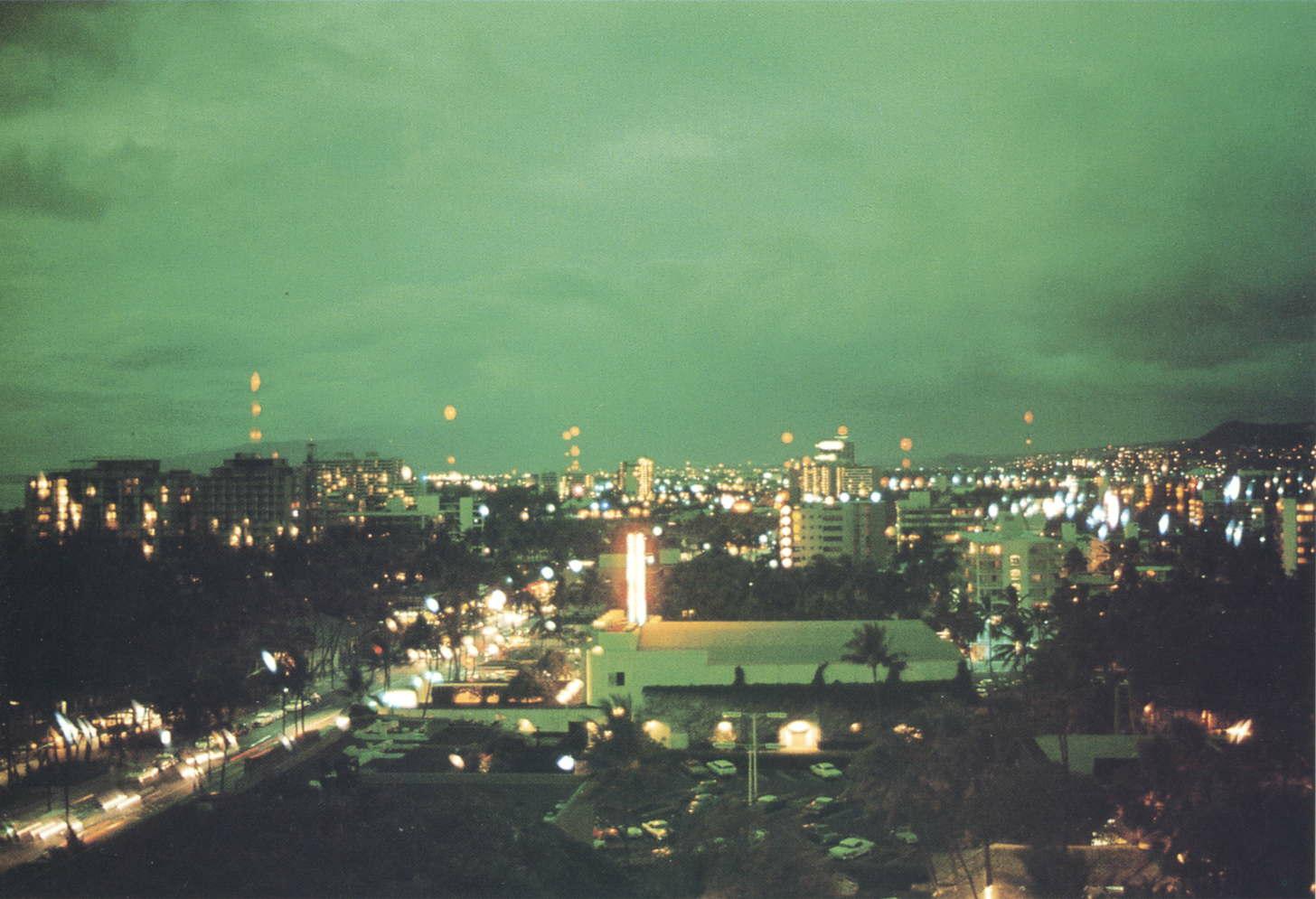
Green H-bomb cloud over Honolulu
– July 19, 1962
800 miles to the west
another US H-bomb
test had been set off
(the first one – 500 times more powerful
than the A-bomb – was tested in 1952). By this time the Soviets had their own
model of the H-bomb. |
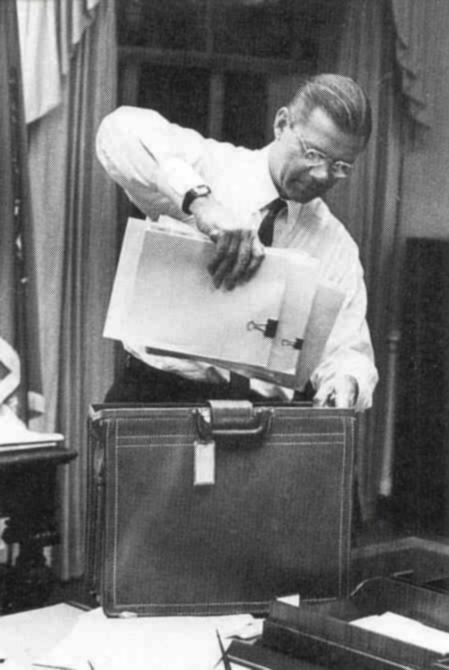
Secretary of Defense Robert
McNamara, whose public comments in the spring of 1962 caused the Soviets to fear
that the US might be planning a pre-emptive nuclear attack
on the Soviet Union
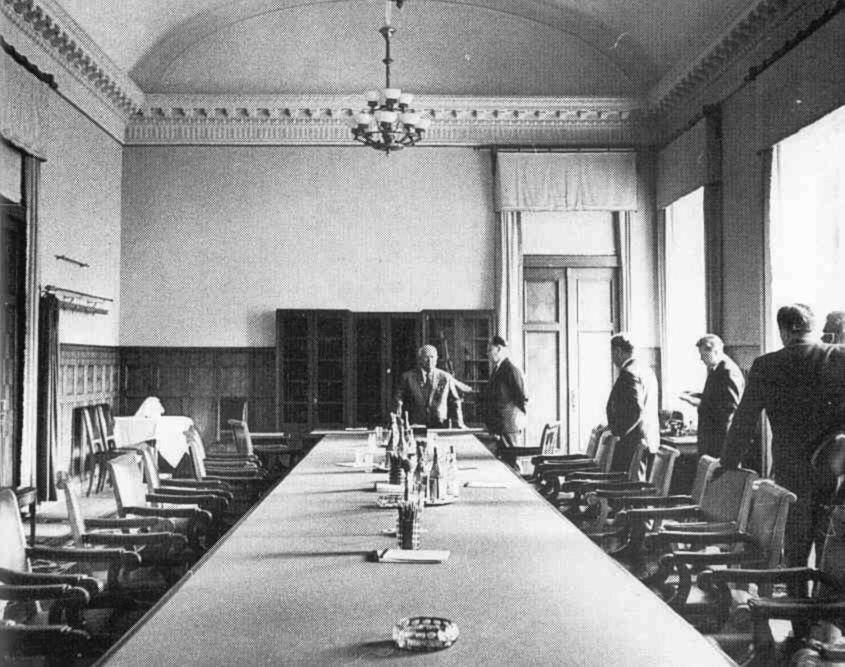
Khrushchev meeting with his
advisers in the Kremlin to discuss the possibility of a US invasion of
Cuba – and the Soviet Union's deterrent
in the form of nuclear tipped ballistic missiles placed in Cuba – April
1962
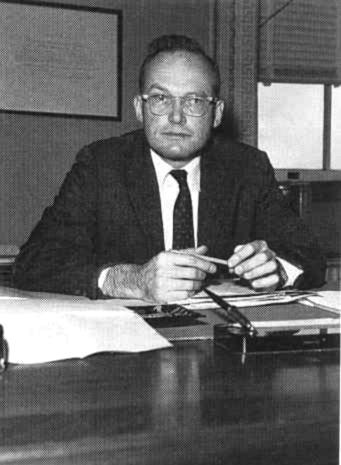
McGeorge Bundy, National
Security Adviser, who informed Kennedy early October 16, 1962, of the building of Soviet
missile bases in Cuba
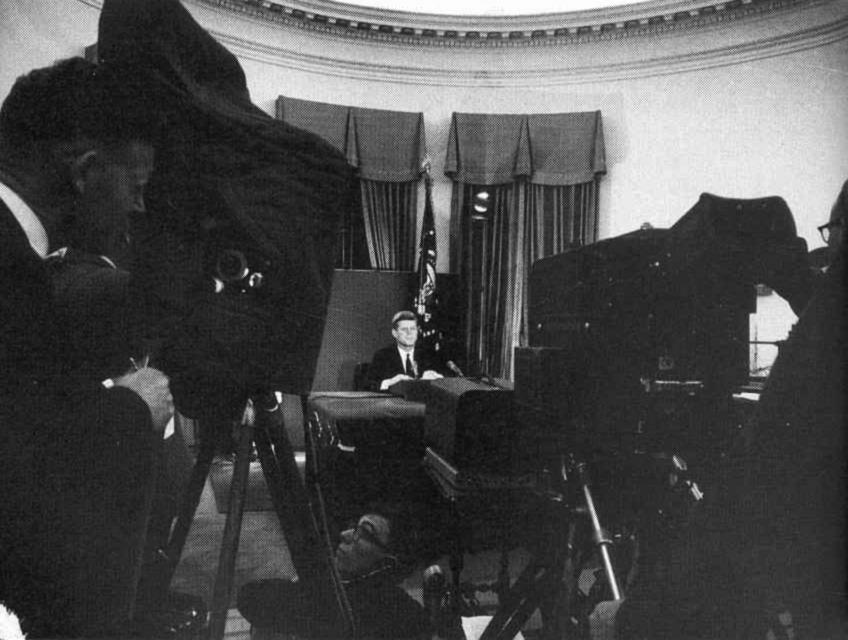
Kennedy's televised announcement
to America about the Cuban missile crisis – and the proposed American
response – October 22, 1962
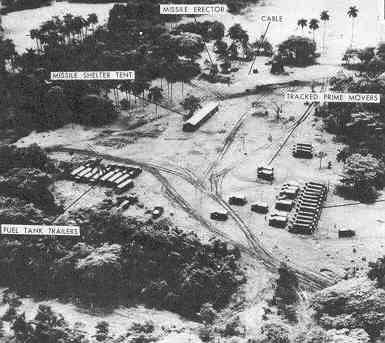 Build-up of Soviet missile
sites in Cuba – 1962
Build-up of Soviet missile
sites in Cuba – 1962
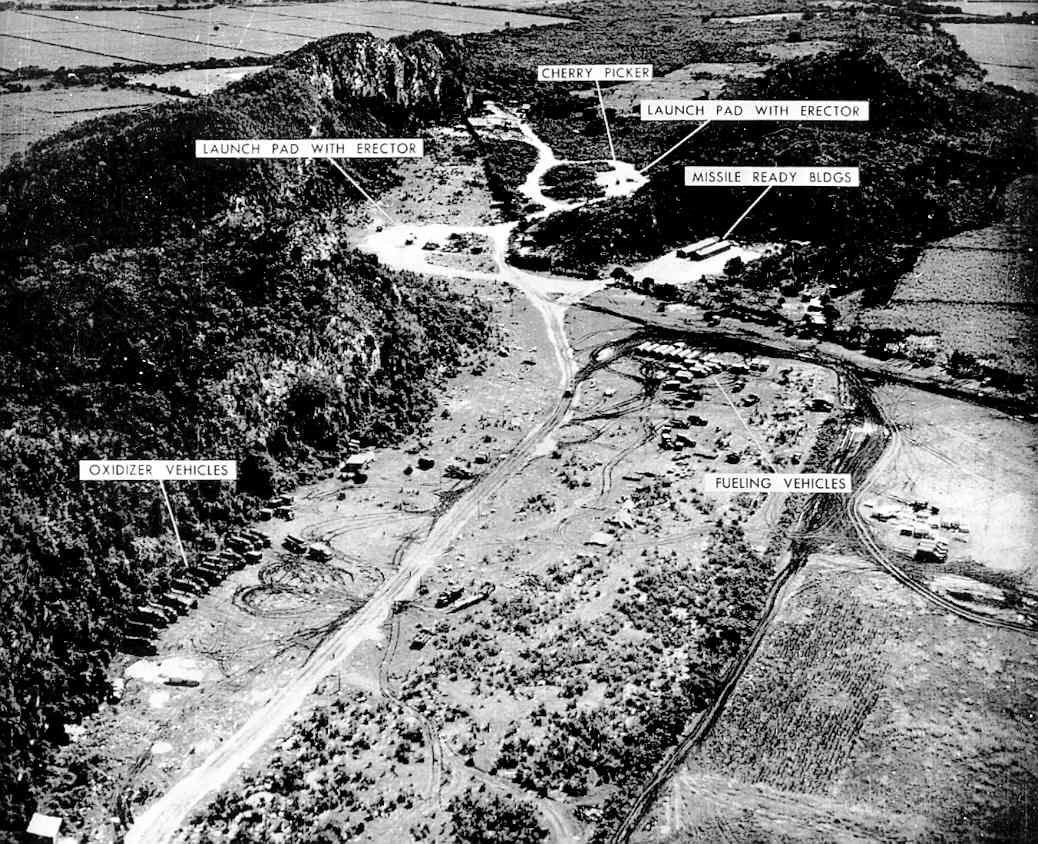
Soviet missile bases in Cuba
– October 15, 1962
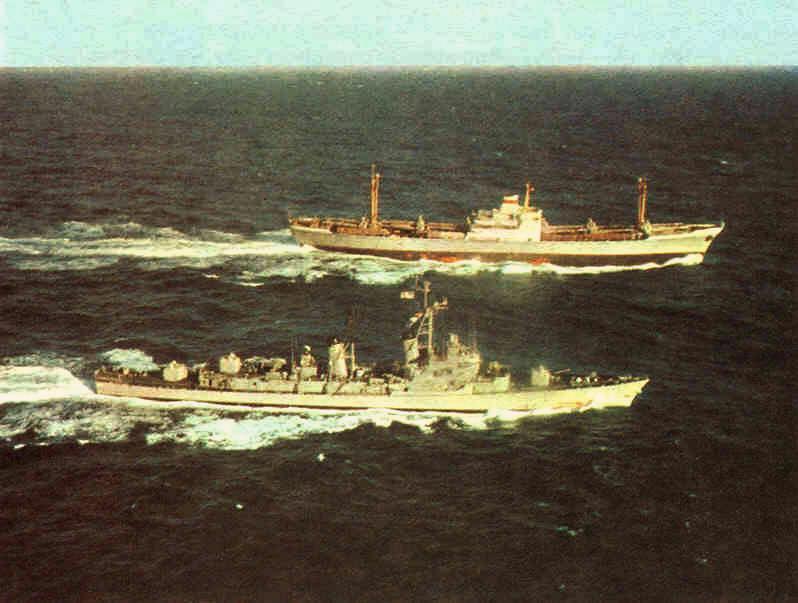
An American warship inspecting
the cargo of a Soviet ship near Cuba – 1962
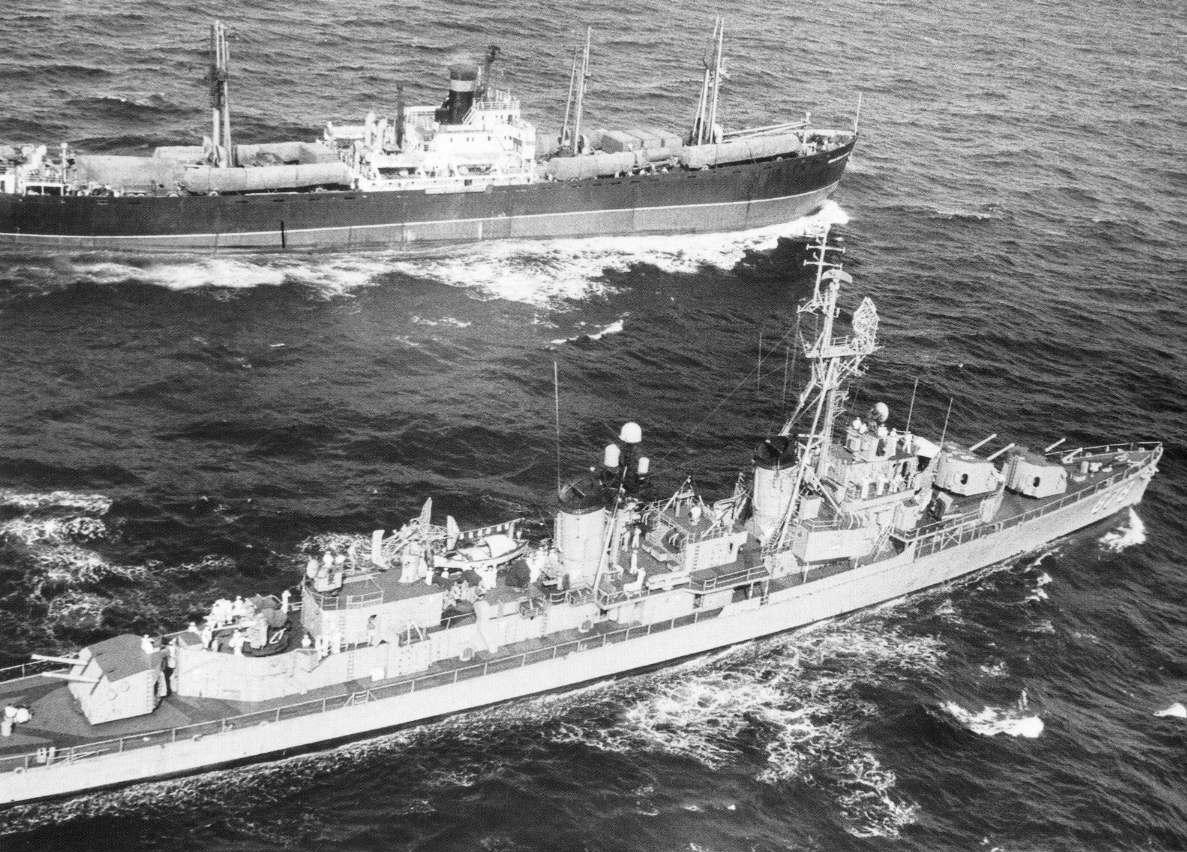
An American warship escorting
a Soviet tanker carrying missiles out of Cuba – summer of 1962
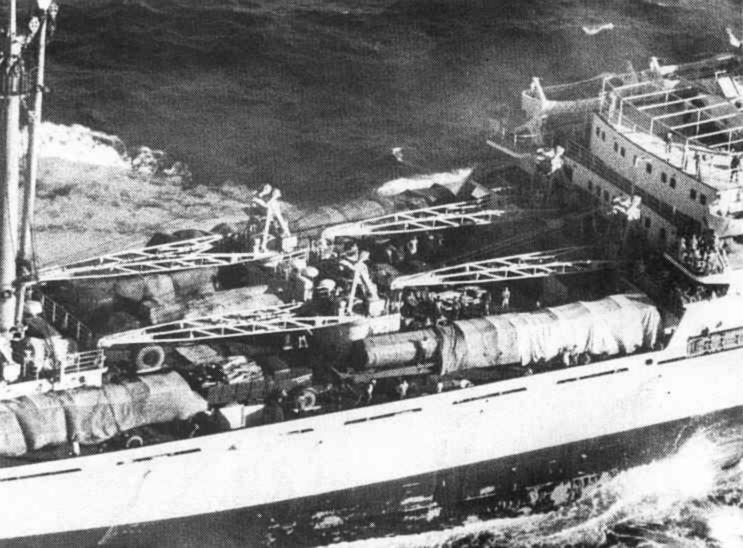 Departure of Soviet missiles
from Cuba
Departure of Soviet missiles
from Cuba
KENNEDY AGAIN ATTEMPTS A SOFT APPROACH TO THE COLD WAR – THE NEXT SUMMER (1963) |
The next summer (1963) Kennedy tries
again to stress that his policy is one of peace for the world – without
surrendering Western freedoms
|
Kennedy revisits the Berlin Wall situation with a personal speech in front of the Wall (June 1963)
Although Kennedy had taken no strong steps to
bring down the hated wall that now surrounded Berlin, he decided to
make of this affront to mankind a chance to score ideological points
against Communism's bullying ways, by coming to Berlin in mid-1963 and
making a speech in front of the wall there. Here he uttered the famous
(but grammatically somewhat misleading) statement, "Ich bin ein
Berliner,"6 as a show of solidarity with the besieged Berliners. Nice, but not impressive, at least not to Soviet Premier Khrushchev.
6What
he should have said was "Ich bin Berliner" (I am Berliner). What he
actually implied when he said that "I am a Berliner" was that he was a
well-known German sweet roll (a "Berliner"). It is sort of like saying
"I am a Hamburger" or "I am a "Frankfurter" (referring to two
well-known foods) rather than "I am Hamburger" or "I am Frankfurter" –
in reference to certain German home-towns! No one is quite
certain as to who it was that advised Kennedy on his German
phrasing! But it certainly was not a German! But the
Germans were gracious enough not to laugh at this very evident mistake
... for they understood the intent of his words.
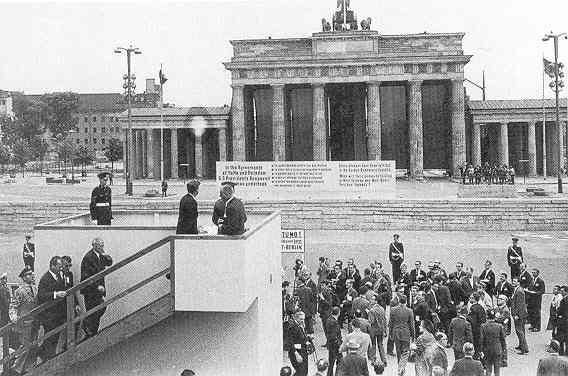 Kennedy at the Berlin Wall
– June 1963
Kennedy at the Berlin Wall
– June 1963
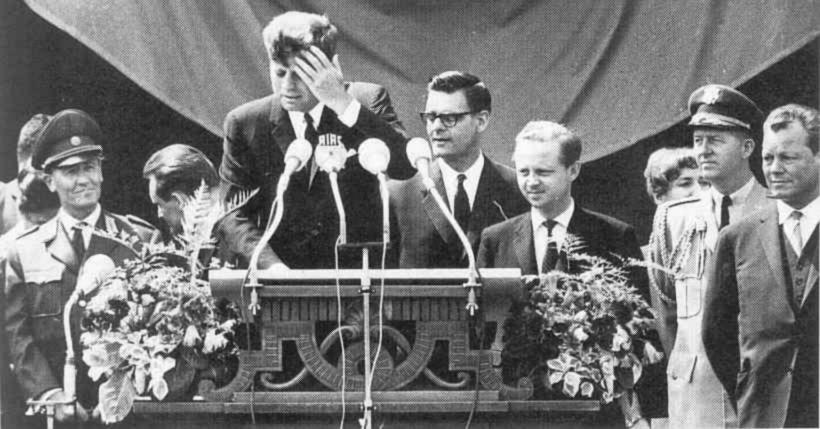
Kennedy delivering his "ich
bin ein Berliner" speech – June 1963
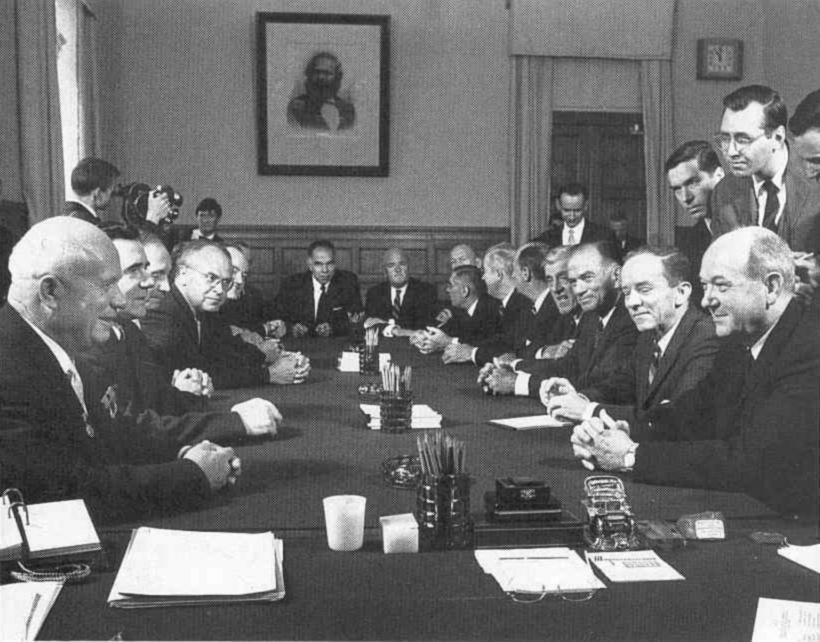
Signing the Test Ban Treaty
in Moscow – August 1963
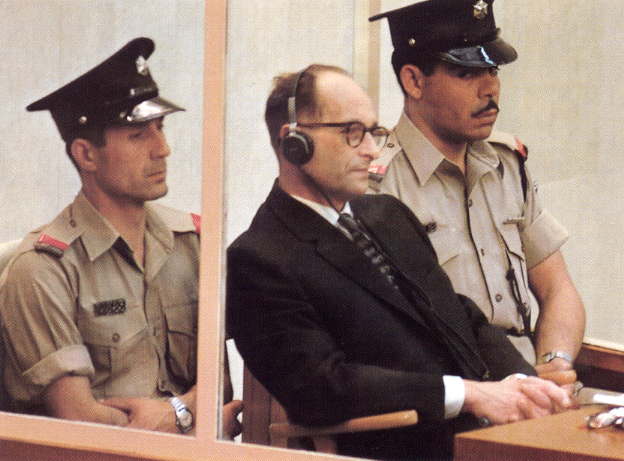
Nazi leader Adolf Eichman in trial in
Jerusalem for genocide against the Jews during World War Two – 1961
NASSER – AND GROWING TENSIONS IN THE MIDDLE EAST |
The Middle East becomes a
major scene of Cold War contentions with the rise of Arab nationalism under
Nasser of Egypt
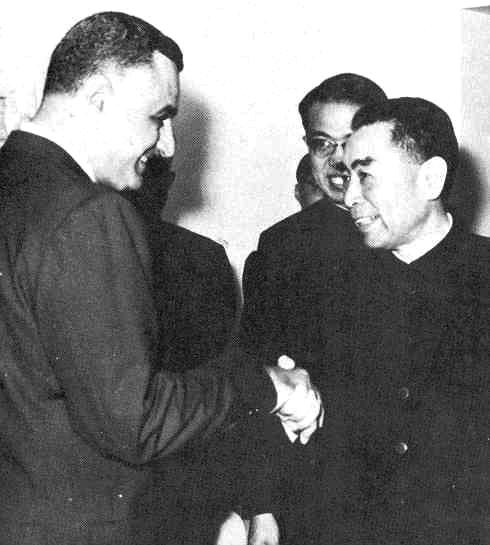
Arab leader Gamal Abdel Nasser
(Egyptian President) meets with Communist Foreign Minister Chou En-lai
– 1963
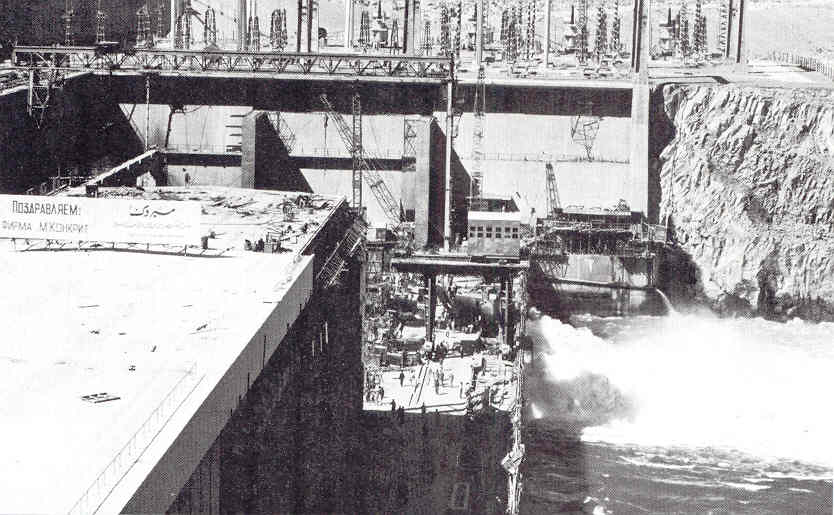
Building the Egyptian Aswan
High Dam (completed in 1971) – with Russian help
THE MOUNTING CRISIS IN VIETNAM |
But the most perplexing problem of all
is the growing threat of communism in old French Indochina –
At first Laos – but then especially
Vietnam
|
Another major problem seemingly facing the nation
was the apparent advance of Communism in the former French Indochina
(Vietnam, Cambodia and Laos).
Political turmoil had rocked old French
Indochina since the collapse of the Japanese Empire in 1945 and the
attempts of the French to re-establish their own Southeast Asian empire
there. Cambodia, Laos and Vietnam had been a constant scene of strife
and civil war among Buddhist peasants and priests, French-speaking
Catholic townsmen, Communist intellectuals, nationalist guerrilla
leaders, and various minority groups scattered throughout the region.
France had finally given up its effort to hold the area and had
withdrawn in 1954-1955. Gradually, with the Communism which had
overtaken China seeming now to be gaining momentum in the Indochina
region, and with France dropping out as the defender there of a
pro-Western status quo, America found itself drawn to the area as the
new protector of that same status quo.
Kennedy was cautious about making a huge
American commitment to the area. He sent military advisors or trainers
to help the Westernized elite in Laos and South Vietnam defend their
land against the Communist soldiers and guerrillas. But this effort did
not seem to be keeping up with the worsening of the crisis in Southeast
Asia, notably Laos, and then Vietnam (and to a lesser extent Cambodia).
Efforts to negotiate a compromise seemed not to slow the progress of
Communism in the region.
One (of several) of Kennedy’s big
concerns about Southeast Asia was the government of the South
Vietnamese strongman Ngo Dinh Diem, who had actually been put in place
in the 1950s by the Americans themselves. His style (because it was
authoritarian – or just because it was highly pro-Catholic?) was
clearly irritating the very people in Vietnam (heavily Buddhist) that
Americans were trying to save from Communism. Kennedy interpreted the
situation as America needing to be more truly supportive of the
democratic process, which Diem hardly symbolized. Thus Kennedy helped
to plan the military overthrow of Diem, hoping idealistically that
Diem’s removal would enable a more "democratic" (and thus supposedly
more pro-American) government to come to power in South Vietnam.
That Kennedy would think that a new
government more committed to Western democracy should satisfy the
Buddhists (one of them burning himself in public protest in June of
1963), whose argument was cultural rather than political, was typical
of the national naïveté that afflicted (and still afflicts) America,
even the sophisticated Kennedy.
Actually, the attempt at removing Diem
led all the way to his (and his brother’s) assassination at the
beginning of November, 1963 – only making the now leaderless South
Vietnamese situation much, much worse. But Kennedy himself was
soon assassinated (merely three weeks later) before anyone could see
what Kennedy planned to do next to get things settled back down in
chaotic post-Diem Vietnam.
|
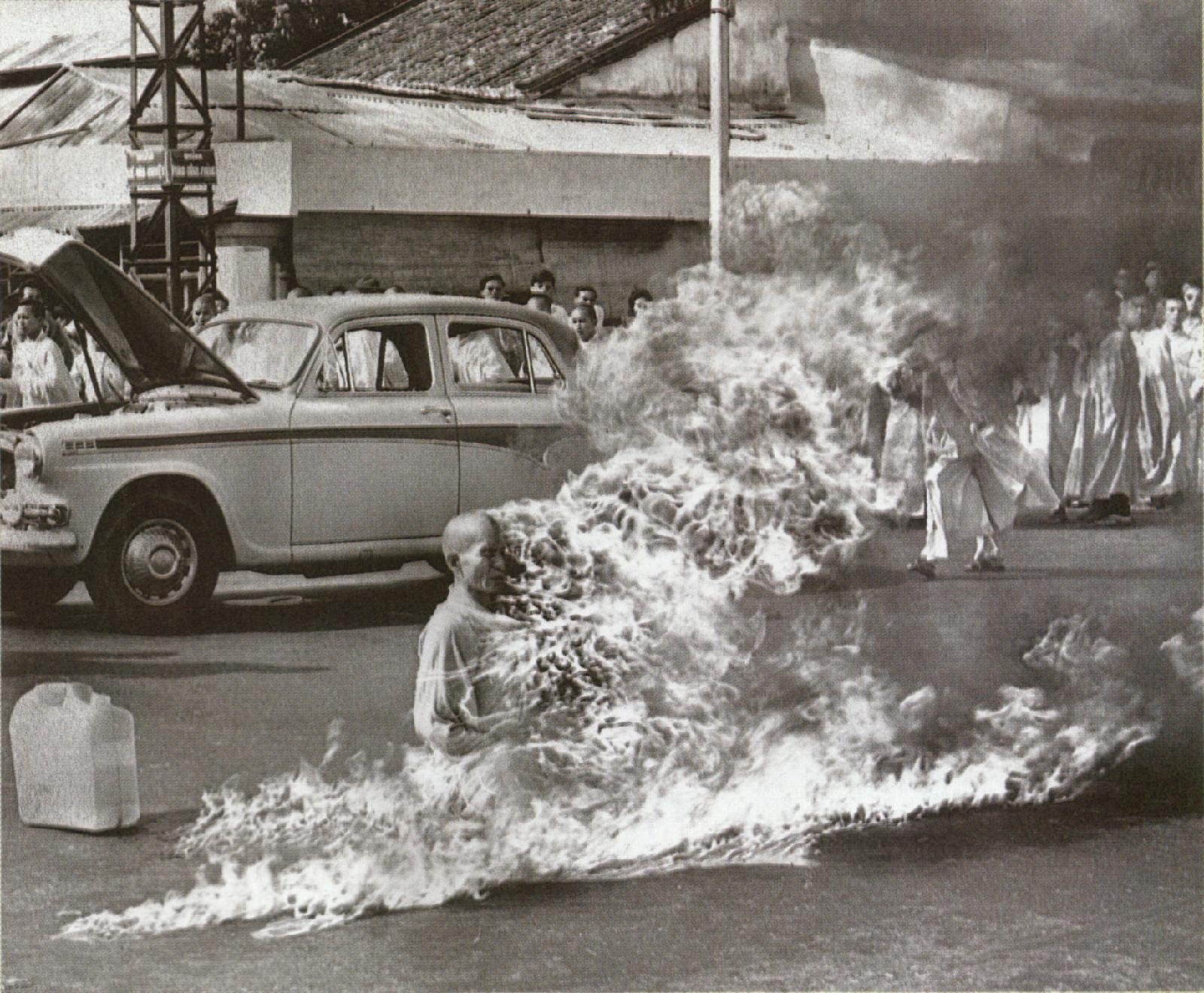
A Buddhist monk, Thich Quang
Duc sets himself on fire in protest against Diem's Western cultural
assault on Vietnamese Buddhist traditionalism – June 11, 1963
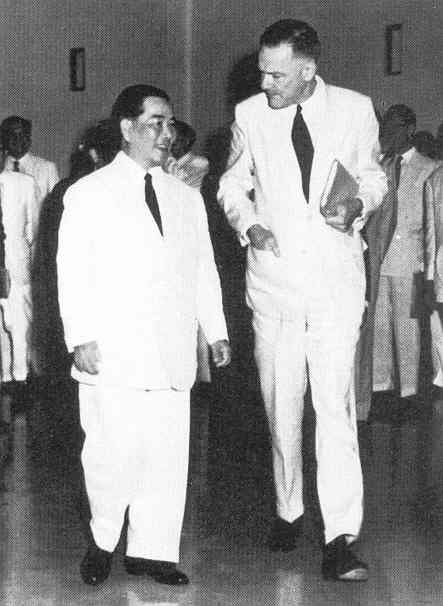
US Ambassador Henry Cabot
Lodge visiting South Vietnamese President Ngo Dinh Diem – October 1963 (while encouraging the military
coup that would assassinate Diem in November)
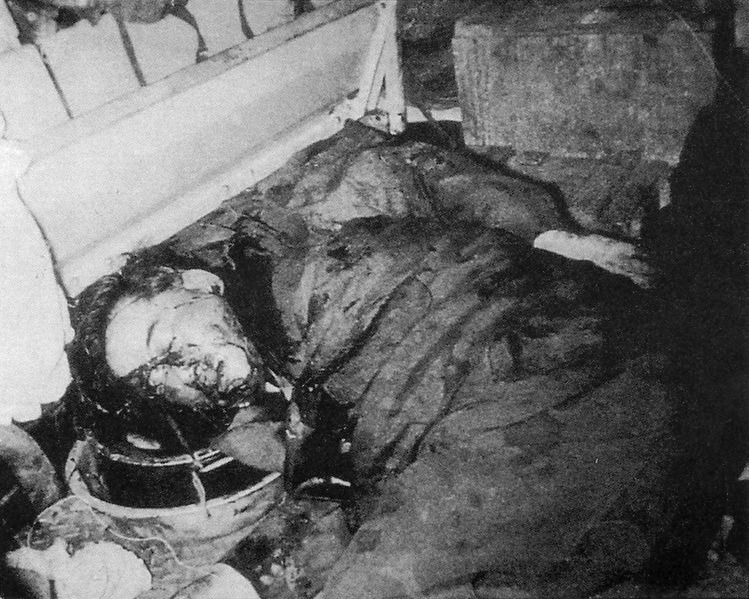 The bloodied body of South
Vietnamese President Ngo Dinh Diem. The military coup started on November
1st. Diem and his brother were killed on the 2nd ... supposedly "opening the door for democracy" in
South Vietnam. But only chaos resulted. South Vietnam would never again
acquire a stabilizing government.
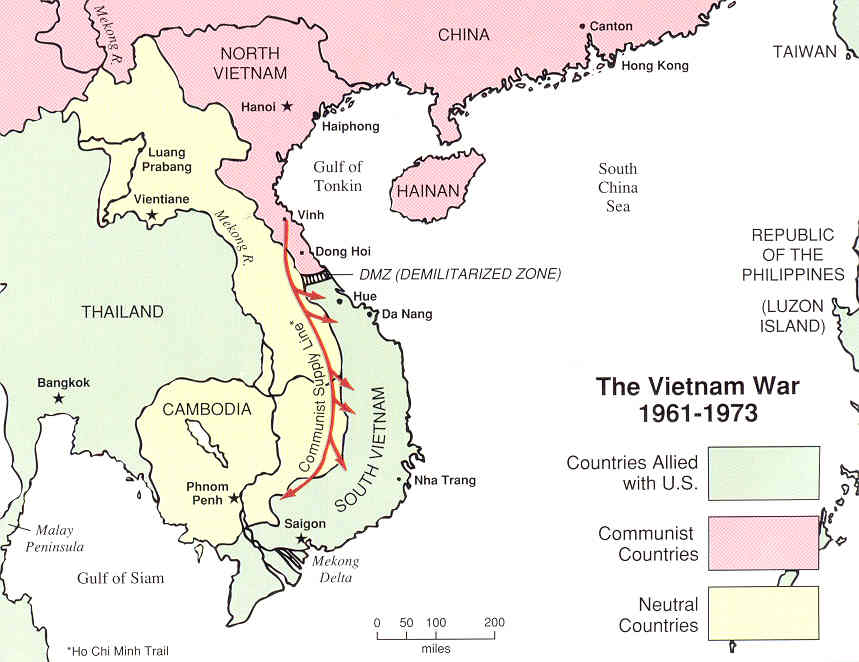

Go on to the next section: Profound Social-Spiritual Challenges
 Miles
H. Hodges Miles
H. Hodges
| | | | |


 The young, energetic, handsome
The young, energetic, handsome The Kennedy White House as "Camelot"
The Kennedy White House as "Camelot"
 Kennedy and the "New Frontier"
Kennedy and the "New Frontier"
 The disastrous Bay of Pigs invasion in
The disastrous Bay of Pigs invasion in South Africa's ethnic disputes
South Africa's ethnic disputes
 The Soviets launch the first man into
The Soviets launch the first man into The failed East-West Summit – June
The failed East-West Summit – June The Berlin wall goes up – August 1961
The Berlin wall goes up – August 1961
 The Cuban Missile Crisis – October 1962
The Cuban Missile Crisis – October 1962
 Kennedy again attempts a soft approach
Kennedy again attempts a soft approach Nasser – and growing tensions in the
Nasser – and growing tensions in the The mounting crisis in Vietnam
The mounting crisis in Vietnam




 Inauguration of John Fitzgerald
Kennedy, January 20, 1961
Inauguration of John Fitzgerald
Kennedy, January 20, 1961



























































